Paul van Yperen's Blog, page 418
May 25, 2014
Mario Parpagnoli
Mario Parpagnoli (?-?) was an Italian actor and director, whose career peaked in the Italian silent cinema of the late 1910s and early 1920s.
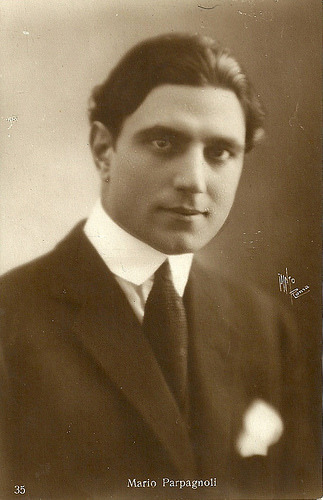
Italian postcard by Ed. A. Traldi, Milano, no. 35. Photo: Pinto, Roma.
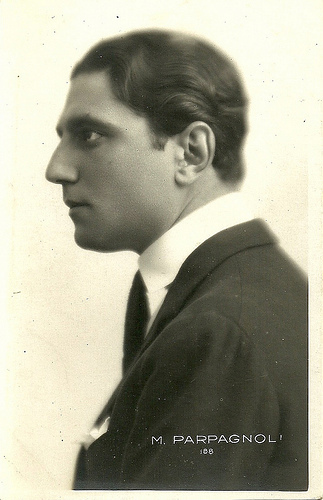
Italian postcard by Ed. G. Vettori, Bologna, no. 188.
Two films that made history
Mario Parpagnoli started his career in 1917 in the Italian silent film L’aquila by Mario Gorgiulo, set in the Italian Risorgimento and based on a play by Arturo Colautti.
A countess who sleeps with two men, has two sons: one is pro-Austrian (played by Parpagnoli), the other pro-Italy (Ubaldo Maria del Colle).
Parpagnoli then acted in two films by Anton Giulio Bragaglia that made history. One is a lost film: Il mio cadavere, which Bragaglia codirected (uncredited) with Riccardo Cassano. It is based on the novel Francesco Lannas (1851) by Francesco Mastriani. Sets were by the Futurist Enrico Prampolini.
Parpagnoli had the male lead as the penniless composer Daniele who hopes for fortune & fame in Naples, but is refused the hand of a young contess until he earns a million. Emigrated, he meets an old gentleman who nominates him his heir. To speed up things Daniele kills the old man, inherits and runs to Naples to marry his countess. But then Daniele discovers that he killed his own father and goes berserk.
Parpagnoli's other film, directed by Bragaglia and Cassano is Thais. Leading actress was Thais Galitzky as an extravagant and cruel femme fatale, who meets her equal in a cold count (Parpagnoli), who rejects both her and her friend Bianca ( Ileana Leonidoff ).
When Thais finally manages to melt the count’s heart and then rejects him, she tells so to Bianca, who is madly in love with the count. Bianca rides away on her horse in a maddening galop and is killed underway. Thais then repents and kills herself by mortal vapours which exit from strange eye-shaped gaps in her room.
The futurist sets were designed again by Enrico Prampolini. A print of Thais was found and restored in Paris, although it is incomplete.
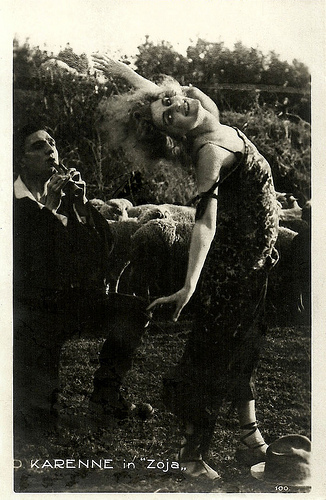
Italian postcard by Vettori, Bologna. Photo: publicity still of Diana Karenne in the Italian silent film Zoya or Zoja (Giulio Antamoro, 1920), a Tiber Film production. The man left might be Mario Parpagnoli.
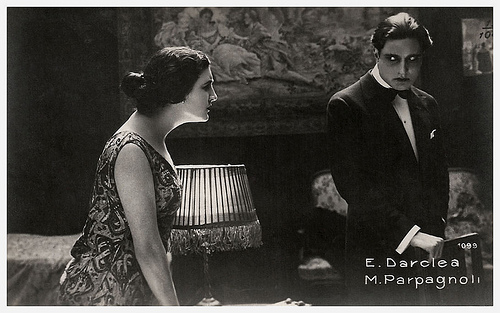
Italian postcard, no. 1099. Edy Darclea and Mario Parpagnoli. Darclea and Parpagnoli played together in two films, Martino il trovatello (Alberto Capozzi, Ubaldo Maria Del Colle, 1919) and La valse ardente (Torello Rolli, 1921).
Hunting for the fortune of a bonvivant
After some neglectable dramas (a.o. with Claretta Rosaj) and a propaganda film, Mario Parpagnoli played the male lead role in the comedy L’Ultimo dei Cognac (Riccardo Cassano, 1918), based on a story by the famous Trilussa, and dealing with heirs hunting for the fortune of a bonvivant.
After a minor role in Martino il trovatello (Alberto Capozzi, 1919), Parpagnoli played the lover of Diana Karenne in La peccatrice casta (Gennaro Righelli, 1919) and again in La signora delle rose ( Diana Karenne , 1919).
Next he was the lover of Vittoria Lepanto in Per aver visto (Enrico Roma, 1920).
In 1920 Parpagnoli peaked with some 10 films in one year. While he had a minor part in the divafilm Chimere (Baldassarre Negroni, 1920) starring Hesperia, he had the male lead opposite Rina Maggi in La complice muta (Livio Pavanelli, 1921), and opposite Pauline Polaire in L’istinto (Baldassarre Negroni, 1920), about a rich writer falling in love with a poor thief.
After the neglectable Liberazione (Jacques Creusy, 1921) and a supporting part in the divafilm Zoya (Giulio Antamoro, 1920) with Diana Karenne , Parpagnoli had the male lead opposite Francesca Bertini in three films.
These were La sfinge (Roberto Roberti, 1921), based on Feuillet’s Le sphynx (1874), Marion, artista di caffè-concerto (Roberto Roberti, 1920), based on Annie Vivanti’s novel, and Maddalena Ferat (Roberto Roberti, 1921), based on Emile Zola’s Madeleine (1865). All three were produced by Francesca Bertini ’s own company.
After another Bertini film L’ultimo sogno (Roberto Roberti, 1921), Parpagnoli was the adventurer who ruins a princess’s family life in La valse ardente (Augusto Genina, 1921), with Edy Darclea and Marcella Sabattini.
The story was shamelessly copied from Bertini's earlier divafilm Sangue bleu (Nino Oxilia, 1914).
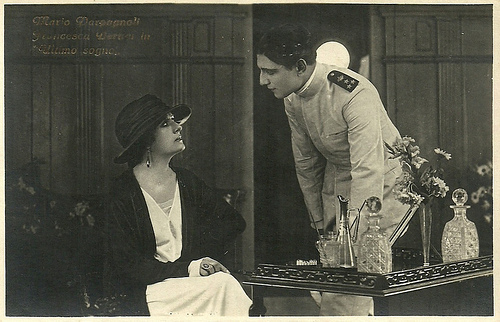
Italian postcard by Ed. G.B. Falci, Milano. Photo: publicity still of Francesca Bertini and Mario Parpagnoli in Ultimo sogno (Roberto Roberti, 1921).
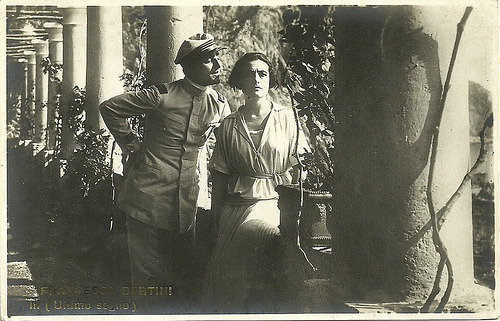
Italian postcard by Ed. G.B. Falci, Milano. Photo: publicity still of Francesca Bertini in Ultimo sogno (Roberto Roberti, 1921). The man could be the male protagonist, played by Mario Parpagnoli.
Haunted by letters of young Venetian girl
In 1922 Mario Parpagnoli was the rival of Sandro Salvini in La fanciulla, il poeta e la laguna by Carmine Gallone.
Parpagnoli is a poet, haunted by letters of young Venetian girl. Cynically and proudly, he asks his secretary to respond to the girl…
He appeared in various films by Toddi starring Vera D’Angara, including the ghost story Al confine della morte (Toddi, 1922), for which Parpagnoli’s performance and the photography by Romagnoli were praised.
Others were Fu cosí che… (Toddi, 1922) and L’amore e il codicillo (Toddi, 1923).
He had a supporting part as bad guy in La rosa di Fortunio (Luciano Doria, 1922) with Diomira Jacobini and Lido Manetti , and another one in the Pina Menichelli vehicle L’ospite sconosciuta (Telemaco Ruggeri, 1923).
It was probably on the set of Mario Bonnard’s adaptation of I promessi sposi/The Betrothed (1922) that Parpagnoli met his future wife, actress Emilia Vidali - daughter of film producer/director/actor Giovanni Enrico Vidali.
She played Lucia while he himself played the evil Don Rodrigo. Italian critics considered the film 'too grey', but audiences loved it and the film was awarded a golden medal at a film festival in Turin in 1923.
For Emilia Vidali , who had been away from the film set for several years, it didn’t mean a full comeback, and after one more film, Amore e destino/Love and Fate (1923) directed by Parpagnoli and with Vidali and Parpagnoli in the leads, she left the Italian screen again.
Vidali and Parpagnoli had married in the meantime. Because of the crisis in the Italian cinema, the couple emigrated to Argentine.
There they played in the film Galleguita (Julio Irigoyen, 1924). In 1930 Parpagnoli scripted and directed in Buenos Aires the musical film Adios Argentina/Goodbye Argentina, in which Mexican star Libertad Lamarque had her debut.
Adios Argentina was originally made as a silent film, but later a soundtrack was added. This succesful tango film starred Ada Cornaro and Pierina Dealessi.
While Vidali returned to Europe in 1930, Parpagnoli remained in Argentine, working as official for the Empresas Filmadroas Italianas in the 1950s.
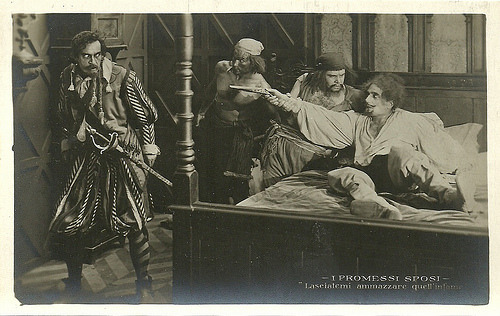
Italian postcard by U.C.I.G. / Vettori, Bologna. Photo: publicity still for the film I promessi sposi (Mario Bonnard, 1922), one of several adaptations of Alessandro Manzoni's famous novel, set in 17th century Italy. Caption: "Let me kill that infamous traitor!"
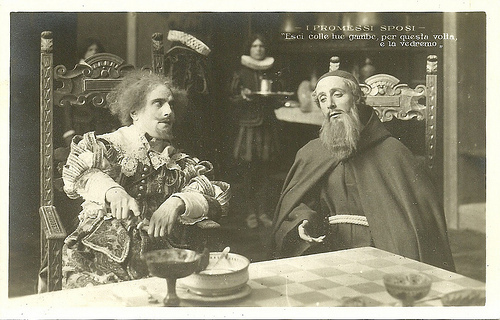
Italian postcard by U.C.I.G. / Vettori, Bologna. Photo: publicity stll for the film I promessi sposi (Mario Bonnard, 1922), one of several adaptations of Alessandro Manzoni's famous novel, set in 17th century Italy. Caption: "Begone this instant, and with unscathed limbs or we'll see."
Sources: Vittorio Martinelli (Il cinema muto italiano, 1917-1930) (Italian), Wikipedia and .

Italian postcard by Ed. A. Traldi, Milano, no. 35. Photo: Pinto, Roma.

Italian postcard by Ed. G. Vettori, Bologna, no. 188.
Two films that made history
Mario Parpagnoli started his career in 1917 in the Italian silent film L’aquila by Mario Gorgiulo, set in the Italian Risorgimento and based on a play by Arturo Colautti.
A countess who sleeps with two men, has two sons: one is pro-Austrian (played by Parpagnoli), the other pro-Italy (Ubaldo Maria del Colle).
Parpagnoli then acted in two films by Anton Giulio Bragaglia that made history. One is a lost film: Il mio cadavere, which Bragaglia codirected (uncredited) with Riccardo Cassano. It is based on the novel Francesco Lannas (1851) by Francesco Mastriani. Sets were by the Futurist Enrico Prampolini.
Parpagnoli had the male lead as the penniless composer Daniele who hopes for fortune & fame in Naples, but is refused the hand of a young contess until he earns a million. Emigrated, he meets an old gentleman who nominates him his heir. To speed up things Daniele kills the old man, inherits and runs to Naples to marry his countess. But then Daniele discovers that he killed his own father and goes berserk.
Parpagnoli's other film, directed by Bragaglia and Cassano is Thais. Leading actress was Thais Galitzky as an extravagant and cruel femme fatale, who meets her equal in a cold count (Parpagnoli), who rejects both her and her friend Bianca ( Ileana Leonidoff ).
When Thais finally manages to melt the count’s heart and then rejects him, she tells so to Bianca, who is madly in love with the count. Bianca rides away on her horse in a maddening galop and is killed underway. Thais then repents and kills herself by mortal vapours which exit from strange eye-shaped gaps in her room.
The futurist sets were designed again by Enrico Prampolini. A print of Thais was found and restored in Paris, although it is incomplete.

Italian postcard by Vettori, Bologna. Photo: publicity still of Diana Karenne in the Italian silent film Zoya or Zoja (Giulio Antamoro, 1920), a Tiber Film production. The man left might be Mario Parpagnoli.

Italian postcard, no. 1099. Edy Darclea and Mario Parpagnoli. Darclea and Parpagnoli played together in two films, Martino il trovatello (Alberto Capozzi, Ubaldo Maria Del Colle, 1919) and La valse ardente (Torello Rolli, 1921).
Hunting for the fortune of a bonvivant
After some neglectable dramas (a.o. with Claretta Rosaj) and a propaganda film, Mario Parpagnoli played the male lead role in the comedy L’Ultimo dei Cognac (Riccardo Cassano, 1918), based on a story by the famous Trilussa, and dealing with heirs hunting for the fortune of a bonvivant.
After a minor role in Martino il trovatello (Alberto Capozzi, 1919), Parpagnoli played the lover of Diana Karenne in La peccatrice casta (Gennaro Righelli, 1919) and again in La signora delle rose ( Diana Karenne , 1919).
Next he was the lover of Vittoria Lepanto in Per aver visto (Enrico Roma, 1920).
In 1920 Parpagnoli peaked with some 10 films in one year. While he had a minor part in the divafilm Chimere (Baldassarre Negroni, 1920) starring Hesperia, he had the male lead opposite Rina Maggi in La complice muta (Livio Pavanelli, 1921), and opposite Pauline Polaire in L’istinto (Baldassarre Negroni, 1920), about a rich writer falling in love with a poor thief.
After the neglectable Liberazione (Jacques Creusy, 1921) and a supporting part in the divafilm Zoya (Giulio Antamoro, 1920) with Diana Karenne , Parpagnoli had the male lead opposite Francesca Bertini in three films.
These were La sfinge (Roberto Roberti, 1921), based on Feuillet’s Le sphynx (1874), Marion, artista di caffè-concerto (Roberto Roberti, 1920), based on Annie Vivanti’s novel, and Maddalena Ferat (Roberto Roberti, 1921), based on Emile Zola’s Madeleine (1865). All three were produced by Francesca Bertini ’s own company.
After another Bertini film L’ultimo sogno (Roberto Roberti, 1921), Parpagnoli was the adventurer who ruins a princess’s family life in La valse ardente (Augusto Genina, 1921), with Edy Darclea and Marcella Sabattini.
The story was shamelessly copied from Bertini's earlier divafilm Sangue bleu (Nino Oxilia, 1914).

Italian postcard by Ed. G.B. Falci, Milano. Photo: publicity still of Francesca Bertini and Mario Parpagnoli in Ultimo sogno (Roberto Roberti, 1921).

Italian postcard by Ed. G.B. Falci, Milano. Photo: publicity still of Francesca Bertini in Ultimo sogno (Roberto Roberti, 1921). The man could be the male protagonist, played by Mario Parpagnoli.
Haunted by letters of young Venetian girl
In 1922 Mario Parpagnoli was the rival of Sandro Salvini in La fanciulla, il poeta e la laguna by Carmine Gallone.
Parpagnoli is a poet, haunted by letters of young Venetian girl. Cynically and proudly, he asks his secretary to respond to the girl…
He appeared in various films by Toddi starring Vera D’Angara, including the ghost story Al confine della morte (Toddi, 1922), for which Parpagnoli’s performance and the photography by Romagnoli were praised.
Others were Fu cosí che… (Toddi, 1922) and L’amore e il codicillo (Toddi, 1923).
He had a supporting part as bad guy in La rosa di Fortunio (Luciano Doria, 1922) with Diomira Jacobini and Lido Manetti , and another one in the Pina Menichelli vehicle L’ospite sconosciuta (Telemaco Ruggeri, 1923).
It was probably on the set of Mario Bonnard’s adaptation of I promessi sposi/The Betrothed (1922) that Parpagnoli met his future wife, actress Emilia Vidali - daughter of film producer/director/actor Giovanni Enrico Vidali.
She played Lucia while he himself played the evil Don Rodrigo. Italian critics considered the film 'too grey', but audiences loved it and the film was awarded a golden medal at a film festival in Turin in 1923.
For Emilia Vidali , who had been away from the film set for several years, it didn’t mean a full comeback, and after one more film, Amore e destino/Love and Fate (1923) directed by Parpagnoli and with Vidali and Parpagnoli in the leads, she left the Italian screen again.
Vidali and Parpagnoli had married in the meantime. Because of the crisis in the Italian cinema, the couple emigrated to Argentine.
There they played in the film Galleguita (Julio Irigoyen, 1924). In 1930 Parpagnoli scripted and directed in Buenos Aires the musical film Adios Argentina/Goodbye Argentina, in which Mexican star Libertad Lamarque had her debut.
Adios Argentina was originally made as a silent film, but later a soundtrack was added. This succesful tango film starred Ada Cornaro and Pierina Dealessi.
While Vidali returned to Europe in 1930, Parpagnoli remained in Argentine, working as official for the Empresas Filmadroas Italianas in the 1950s.

Italian postcard by U.C.I.G. / Vettori, Bologna. Photo: publicity still for the film I promessi sposi (Mario Bonnard, 1922), one of several adaptations of Alessandro Manzoni's famous novel, set in 17th century Italy. Caption: "Let me kill that infamous traitor!"

Italian postcard by U.C.I.G. / Vettori, Bologna. Photo: publicity stll for the film I promessi sposi (Mario Bonnard, 1922), one of several adaptations of Alessandro Manzoni's famous novel, set in 17th century Italy. Caption: "Begone this instant, and with unscathed limbs or we'll see."
Sources: Vittorio Martinelli (Il cinema muto italiano, 1917-1930) (Italian), Wikipedia and .
Published on May 25, 2014 23:00
May 24, 2014
Jimmy Gaillard
French dancer and singer Jimmy Gaillard (1916-1985) began as a child star. He made dozens of films till he ha d to terminate his career because of a grave car accident.
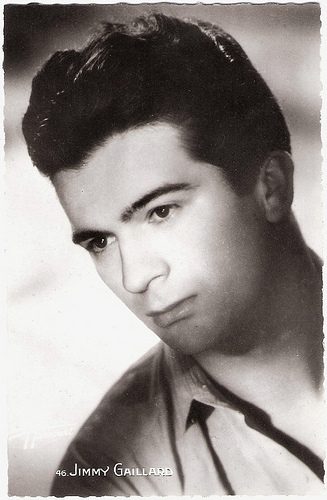
French postcard by S.E.R.P., Paris, no. 46. Photo: Studio Harcourt.
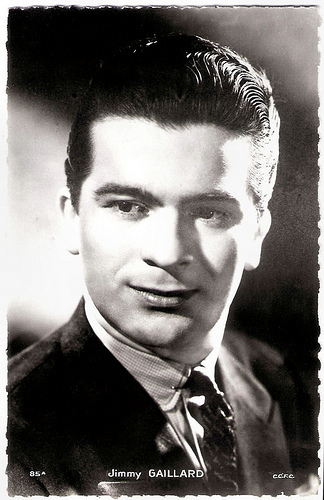
French postcard by Editions Chantal, Rueil, no. 85a. Photo: C.C.F.C.
Born To Dance
Jimmy Gaillard was born as Maurice Gurtner in Lyon, France, in 1916.
Jimmy (also credited as Jimmy and Jimay) was born to dance. He made his stage debut at the age of seven, and his film debut in the silent costume drama Le miracle des loups/Miracle of the Wolves (Raymond Bernard, 1924).
As a boy he was also seen in the incredibly funny extravaganza Le Mystère de la tour Eiffel/The Mystery of the Eiffel Tower (Julien Duvivier, 1927), L’argent/The Money (Marcel L’Herbier, 1928) starring Brigitte Helm , and Coeur de Paris/The Heart of Paris (Jean Benoît-Lévy, Marie Epstein, 1930).
He was sent to New York to sing and dance in Broadway shows that starred Eddie Cantor and Bing Crosby.
Jimmy returned to France and performed in operettas and joined the orchestras of Jo Bouillon and Ray Ventura.
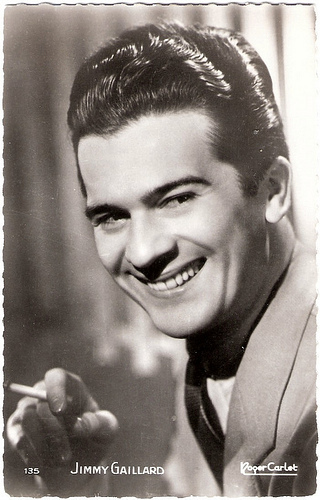
French postcard by Editions P.I., Paris, no. 135; presented by the chocolate firm N.V. Victoria, Brussels, Belgium. Photo: Roger Carlet.
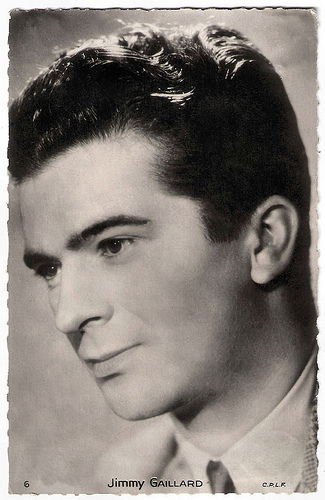
French postcard by Editions E.C., Paris, no. 6. Photo: C.P.L.F.
The Wheel Turns
As a young adult Jimmy Gaillard appeared opposite Michèle Morgan in L'entraîneuse/Nightclub Hostess (Albert Valentin, 1938).
At the side of Ray Ventura he performed in such light comedies as Feux de joie/Bonfire (Jacques Houssin, 1938) with René Lefèvre , and Tourbillon de Paris/Whirlwind of Paris (Henri Diamant-Berger, 1939).
After the war he played in such musicals as Musique en tête/Music in Mind (Georges Combret, Claude Orval, 1951) with Irène de Trebert , and Tambour battant/Briskly (Georges Combret, 1952).
In 1952 Jimmy was the victim of a grave car accident and had to terminate his acting career. He only made some guest appearances as himself in show films like Bonjour sourire/Hello Smile (Claude Sautet, 1955) with Louis de Funès .
At the end of his life, he consecrated himself to the association La Roue tourne (The Wheel Turns) to help other victims of accidents.
Jimmy Gaillard died in 1985 in Nice, France. He was 68.
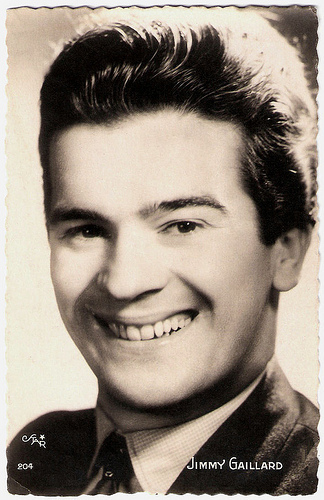
French postcard by Editions O.P., Paris, no. 204. Photo: Star.
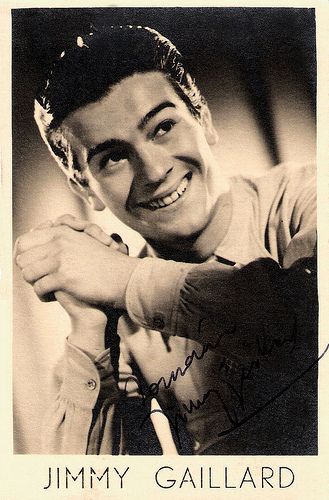
French postcard.
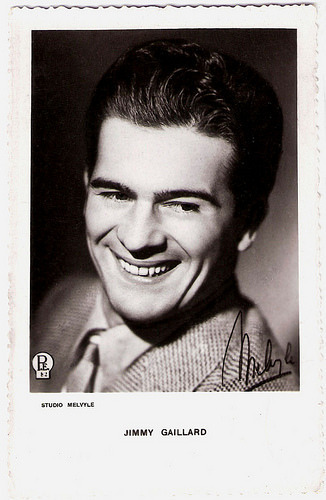
Belgian postcard by Editions P.E., no. 82. Studio Melvyle.
Sources: Yvan Foucart (Le gens du cinema), Ciné-ressources (French) and .

French postcard by S.E.R.P., Paris, no. 46. Photo: Studio Harcourt.

French postcard by Editions Chantal, Rueil, no. 85a. Photo: C.C.F.C.
Born To Dance
Jimmy Gaillard was born as Maurice Gurtner in Lyon, France, in 1916.
Jimmy (also credited as Jimmy and Jimay) was born to dance. He made his stage debut at the age of seven, and his film debut in the silent costume drama Le miracle des loups/Miracle of the Wolves (Raymond Bernard, 1924).
As a boy he was also seen in the incredibly funny extravaganza Le Mystère de la tour Eiffel/The Mystery of the Eiffel Tower (Julien Duvivier, 1927), L’argent/The Money (Marcel L’Herbier, 1928) starring Brigitte Helm , and Coeur de Paris/The Heart of Paris (Jean Benoît-Lévy, Marie Epstein, 1930).
He was sent to New York to sing and dance in Broadway shows that starred Eddie Cantor and Bing Crosby.
Jimmy returned to France and performed in operettas and joined the orchestras of Jo Bouillon and Ray Ventura.

French postcard by Editions P.I., Paris, no. 135; presented by the chocolate firm N.V. Victoria, Brussels, Belgium. Photo: Roger Carlet.

French postcard by Editions E.C., Paris, no. 6. Photo: C.P.L.F.
The Wheel Turns
As a young adult Jimmy Gaillard appeared opposite Michèle Morgan in L'entraîneuse/Nightclub Hostess (Albert Valentin, 1938).
At the side of Ray Ventura he performed in such light comedies as Feux de joie/Bonfire (Jacques Houssin, 1938) with René Lefèvre , and Tourbillon de Paris/Whirlwind of Paris (Henri Diamant-Berger, 1939).
After the war he played in such musicals as Musique en tête/Music in Mind (Georges Combret, Claude Orval, 1951) with Irène de Trebert , and Tambour battant/Briskly (Georges Combret, 1952).
In 1952 Jimmy was the victim of a grave car accident and had to terminate his acting career. He only made some guest appearances as himself in show films like Bonjour sourire/Hello Smile (Claude Sautet, 1955) with Louis de Funès .
At the end of his life, he consecrated himself to the association La Roue tourne (The Wheel Turns) to help other victims of accidents.
Jimmy Gaillard died in 1985 in Nice, France. He was 68.

French postcard by Editions O.P., Paris, no. 204. Photo: Star.

French postcard.

Belgian postcard by Editions P.E., no. 82. Studio Melvyle.
Sources: Yvan Foucart (Le gens du cinema), Ciné-ressources (French) and .
Published on May 24, 2014 23:00
May 23, 2014
Albert Matterstock
German actor and writer Albert Matterstock (1909 or 1911-1960) belonged to the group of successful young actors from the mid-1930s who conquered the heart of the German public with entertainment films. He made 40 films before he died as a result of his morphine addiction.
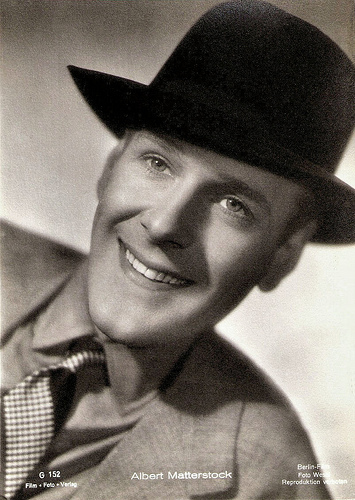
German postcard by Film-Foto-Verlag, no. G 152. Photo: Foto Wesel / Berlin Film.
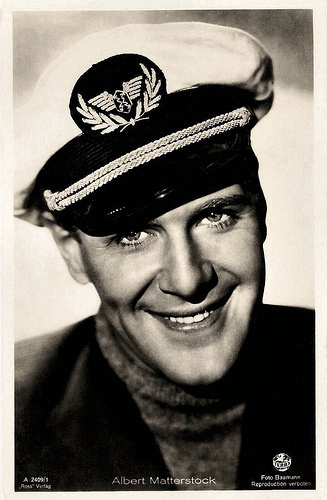
German postcard by Ross Verlag, no. A 2409/1,1939-1940. Photo: Baumann / Terra.
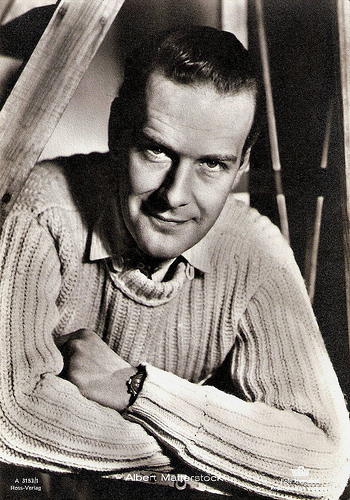
German postcard by Ross Verlag, no. A 3153/1, 1941-1944. Photo: Tobis / Haenchen.
Elegant Men of the World
Albert Andreas Hermann Walter Matterstock was born in Leipzig as the son of a cavalry officer. He attended the Colonial School in Witzenhausen, and later lived till his 21st birthday with relatives in Africa.
Matterstock had acting classes in Berlin from Leontine Sagan at the Max Reinhardt Seminar. He made his stage debut at the Theater am Kurfürstendamm, and soon he became known as a portrayer of elegant men of the world.
Reinhold Schünzel discovered him for the cinema. His debut Land der Liebe/Land of Love ( Reinhold Schünzel , 1937) made him immediately a popular star. Many of his following films would be box office hits and he became one of the highest paid stars of the Ufa.
To those films belong romances and comedies like Serenade ( Willi Forst , 1937) with Hilde Krahl , Stimme des Blutes/Voice of the Blood (Carmine Gallone, 1937) opposite Anneliese Uhlig , Ziel in den Wolken/Goal in the Clouds ( Wolfgang Liebeneiner , 1938) with Leny Marenbach and Brigitte Horney , Gastspiel im Paradies/Guest performance in paradise (Karl Hartl, 1938) again opposite Hilde Krahl, Lauter Lügen/Many Lies ( Heinz Rühmann , 1938) with Hertha Feiler , and Ein ganzer Kerl/A Regular Fellow (Fritz Peter Buch, 1939) with Heidemarie Hatheyer .
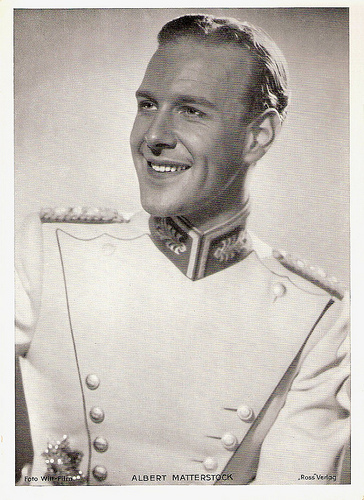
Big German card by Ross Verlag. Photo: Witt-Film.
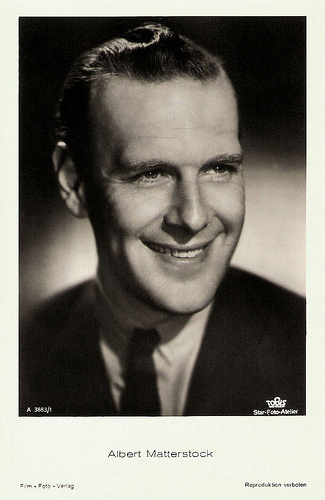
German postcard by Film-Foto-Verlag, no. A 3883/1, 1941-1944. Photo: Tobis / Star-Foto-Atelier.
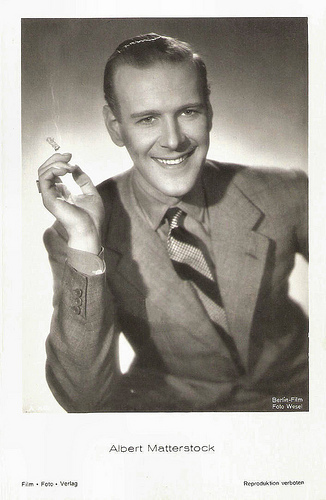
German postcard by Film-Foto-Verlag, no. A 3686/1, 1941-1944. Photo: Foto Wesel / Berlin Film.
Morphine
During wartime Albert Matterstock went on to play roles in comedies like Unser Fräulein Doktor/Our Miss Doctor (Erich Engel, 1940) with Jenny Jugo , Das himmelblaue Abendkleid/Charivan (Erich Engel, 1941) with Elfie Mayerhofer , Kollege kommt gleich/My Colleague is Coming (Karl Anton, 1943) with Carola Höhn , Ein Walzer mit Dir/A Waltz With You (Hubert Marischka, 1943) opposite Lizzi Waldmüller , and Frühlingsmelodie/Springtime Melody (Hans Robert Bortfeld, 1945).
In 1943 he was wounded during the shooting of a film on sea, and he got treated with morphine. It soon became a nasty habit.
After the war Albert Matterstock wasn't able to go on from his earlier successes. He only was offered supporting parts.
To his few post-war films belong mediocre fare like Spuk im Schloß/A Ghost in the Castle (Hans H. Zerlett, 1947), Schuss um Mitternacht/A Shot at Midnight (Hans H. Zerlett, 1949), and Drei Birken auf der Heide/Three Birch Trees at the Moor (Ulrich Erfurth, 1956).
He mostly worked in the theatre, but he also had to earn his money as a car salesman and a barkeeper. Some periods he was even homeless.
In 1960 Albert Matterstock died in a hotel in Hamburg at the age of 49 as a result of his addiction to morphine.
He was married four times, a.o. to Margot Rauh and
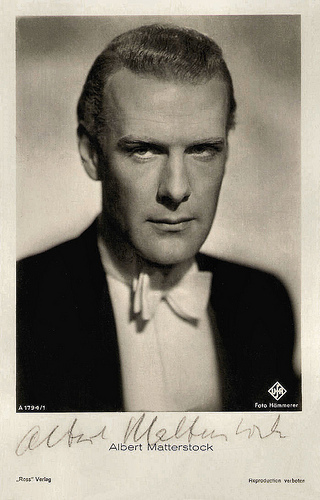
German postcard by Ross-Verlag, no. A 1794/1, 1937-1938. Photo: Ufa / Hämmerer.
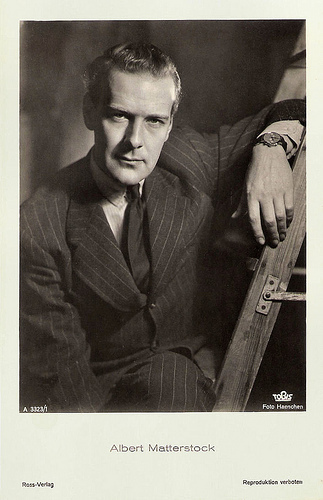
German postcard by Ross Verlag, no. A 3323/1, 1941-1944. Photo: Tobis / Haenchen.
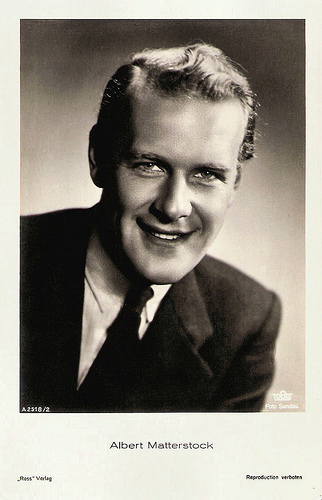
German postcard by Ross Verlag, no. A 2518/2, 1939-1940. Photo: Tobis / Sandau.
Sources: Thomas Staedeli (Cyranos), Stephanie D'Heil (Steffi-line)(German), Wikipedia (German), and .

German postcard by Film-Foto-Verlag, no. G 152. Photo: Foto Wesel / Berlin Film.

German postcard by Ross Verlag, no. A 2409/1,1939-1940. Photo: Baumann / Terra.

German postcard by Ross Verlag, no. A 3153/1, 1941-1944. Photo: Tobis / Haenchen.
Elegant Men of the World
Albert Andreas Hermann Walter Matterstock was born in Leipzig as the son of a cavalry officer. He attended the Colonial School in Witzenhausen, and later lived till his 21st birthday with relatives in Africa.
Matterstock had acting classes in Berlin from Leontine Sagan at the Max Reinhardt Seminar. He made his stage debut at the Theater am Kurfürstendamm, and soon he became known as a portrayer of elegant men of the world.
Reinhold Schünzel discovered him for the cinema. His debut Land der Liebe/Land of Love ( Reinhold Schünzel , 1937) made him immediately a popular star. Many of his following films would be box office hits and he became one of the highest paid stars of the Ufa.
To those films belong romances and comedies like Serenade ( Willi Forst , 1937) with Hilde Krahl , Stimme des Blutes/Voice of the Blood (Carmine Gallone, 1937) opposite Anneliese Uhlig , Ziel in den Wolken/Goal in the Clouds ( Wolfgang Liebeneiner , 1938) with Leny Marenbach and Brigitte Horney , Gastspiel im Paradies/Guest performance in paradise (Karl Hartl, 1938) again opposite Hilde Krahl, Lauter Lügen/Many Lies ( Heinz Rühmann , 1938) with Hertha Feiler , and Ein ganzer Kerl/A Regular Fellow (Fritz Peter Buch, 1939) with Heidemarie Hatheyer .

Big German card by Ross Verlag. Photo: Witt-Film.

German postcard by Film-Foto-Verlag, no. A 3883/1, 1941-1944. Photo: Tobis / Star-Foto-Atelier.

German postcard by Film-Foto-Verlag, no. A 3686/1, 1941-1944. Photo: Foto Wesel / Berlin Film.
Morphine
During wartime Albert Matterstock went on to play roles in comedies like Unser Fräulein Doktor/Our Miss Doctor (Erich Engel, 1940) with Jenny Jugo , Das himmelblaue Abendkleid/Charivan (Erich Engel, 1941) with Elfie Mayerhofer , Kollege kommt gleich/My Colleague is Coming (Karl Anton, 1943) with Carola Höhn , Ein Walzer mit Dir/A Waltz With You (Hubert Marischka, 1943) opposite Lizzi Waldmüller , and Frühlingsmelodie/Springtime Melody (Hans Robert Bortfeld, 1945).
In 1943 he was wounded during the shooting of a film on sea, and he got treated with morphine. It soon became a nasty habit.
After the war Albert Matterstock wasn't able to go on from his earlier successes. He only was offered supporting parts.
To his few post-war films belong mediocre fare like Spuk im Schloß/A Ghost in the Castle (Hans H. Zerlett, 1947), Schuss um Mitternacht/A Shot at Midnight (Hans H. Zerlett, 1949), and Drei Birken auf der Heide/Three Birch Trees at the Moor (Ulrich Erfurth, 1956).
He mostly worked in the theatre, but he also had to earn his money as a car salesman and a barkeeper. Some periods he was even homeless.
In 1960 Albert Matterstock died in a hotel in Hamburg at the age of 49 as a result of his addiction to morphine.
He was married four times, a.o. to Margot Rauh and

German postcard by Ross-Verlag, no. A 1794/1, 1937-1938. Photo: Ufa / Hämmerer.

German postcard by Ross Verlag, no. A 3323/1, 1941-1944. Photo: Tobis / Haenchen.

German postcard by Ross Verlag, no. A 2518/2, 1939-1940. Photo: Tobis / Sandau.
Sources: Thomas Staedeli (Cyranos), Stephanie D'Heil (Steffi-line)(German), Wikipedia (German), and .
Published on May 23, 2014 23:00
May 22, 2014
Claude Jade
French actress Claude Jade (1948–2006) is best remembered Christine in François Truffaut's films Baisers volés/Stolen Kisses (1968), Domicile Conjugal/Bed and Board (1970) and L'amour en fuite/Love on the Run (1979). Outside of France she played in films in the Soviet Union, the United States, Italy and Japan.
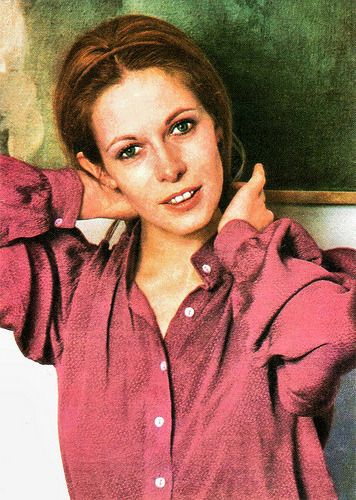
Romanian postcard by Casa Filmului Acin.
New Wave
Claude Jade was born as Claude Marcelle Jorré in Dijon, France in 1948. She was the daughter of university professors.
Jade spent three years at Dijon's Conservatory of Dramatic Art, where in 1964 she won a best actress prize for her portrayal of Agnès in Molière's L'école des femmes (School of Wives).
In 1966 she won the Prix de Comédie for Jean Giraudoux's stage play Ondine, performed at the Comédie Boulogne. She moved to Paris and became a student of Jean-Laurent Cochet at the Edouard VII theatre, in a class with Gérard Depardieu .
She also began acting in television productions, including a leading role in the TV series Les oiseaux rares. While performing as Frida in Luigi Pirandello's Henri IV (Henry IV) at the Théâtre Moderne, Jade was discovered by Nouvelle Vague (New Wave) film director François Truffaut.
Truffaut cast her in the role of violin student Christine Darbon in Baisers volés/Stolen Kisses (1968). It continues the story of the character Antoine Doinel (Jean-Pierre Léaud), whom Truffaut had previously depicted in Les 400 Coups/The 400 Blows and the short film Antoine et Colette/Antoine and Colette.
During the filming, Jade and Truffaut were engaged at one point. According to Ronald Bergan in The Guardian “Truffaut's love for his young discovery illuminated her scenes”.
Baisers volés was nominated for Academy Award for Best Foreign Language Film and put Jade in the international spotlight for her strong performance. As Christine she teaches Antoine the best way to butter toast in the morning, and there are many more memorable scenes.
Playing the same character, Jade appeared in two more films by Truffaut, Domicile Conjugal/Bed and Board (1970), and L'amour en fuite/Love on the Run (1979). Truffaut uses the occasion to examine three states, three ages, of his heroine, played with the right middle-class gentility and innocence by Claude Jade: loved from a distance (Stolen Kisses), married and misled (Bed & Board), divorced but still on good terms (Love on the Run).
Recommended by Truffaut, Jade starred in Alfred Hitchcock's espionage thriller Topaz (1969). She played Michèle Picard, a secret agent's anxious daughter, married to a reporter (Michel Subor). Jade was 19 years old when cast, with Frederick Stafford as her father and Dany Robin playing her mother. Some of her scenes were deleted and restored for the director's cut of Topaz in 1999.
Topaz was Jade's only Hollywood film. Universal Pictures offered her a seven-year contract, which she turned down reportedly because she preferred to work in French.
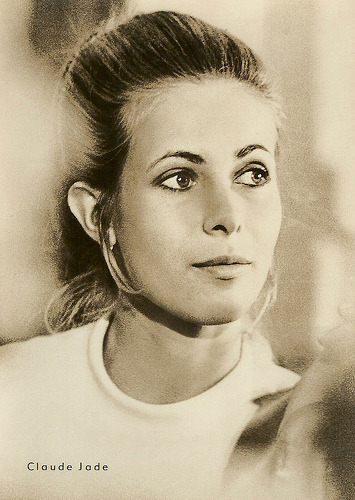
East-German postcard by VEB Progress Filmvertrieb, Berlin. Collection: Didier Hanson.
Italian Films
Claude Jade was to have starred as Romola, Vaslav Nijinsky's wife in Nijinsky (Tony Richardson, 1970), alongside Rudolf Nureyev as Nijinsky and Paul Scofield as his lover Sergei Diaghilev The film, based on a screenplay by Edward Albee, was cancelled during pre-production by producer Harry Saltzman.
She did star in the historical film Mon oncle Benjamin/My Uncle Benjamin (Édouard Molinaro, 1969) alongside Jacques Brel as his fiancée Manette, who refuses his advances until he produces a marriage contract.
She also had a leading role as Linda in a modern The Count of Monte Cristo-adaptation, Sous le signe de Monte Cristo/Under the Sign of Montecristo (André Hunebelle, 1968).
Her career continued in Belgium, where she played a young English teacher who is fatally intrigued by a murderer (Gérard Barray) in the film Le Témoin/The Witness (Anne Walter, 1969). That year she also starred in a television adaptation of William Shakespeare's A Midsummer Night's Dream (Jean-Christophe Averty, 1969).
In the early 1970s, Jade starred in films like Le bateau sur l'herbe/The Boat on the Grass (Gérard Brach, 1971), as Eleonore, a young girl between two friends ( Jean-Pierre Cassel , John McEnery), and Les feux de la chandeleur/Hearth Fires (Serge Korber, 1972) as Laura, a daughter who wants to reconcile her parents ( Annie Girardot , Jean Rochefort) and who falls in love with her mother's best friend (Bernard Fresson).
Alongside to Robert Hossein she played the priest's love Françoise in Prêtres interdits/Forbidden Priests (Denys de La Patellière, 1973). In Home Sweet Home (Benoît Lamy, 1973), she played a hardened nurse who is changed by a love affair with a social worker (Jacques Perrin). She played a dual role in Le choix/The Choice (Jacques Faber, 1976).
Jade starred in three Italian films: as a private investigator in Number One (Gianni Buffardi, 1973), as Tiffany, the girlfriend of a private eye (Frederick Stafford) in La ragazza di via Condotti/Special Killers (German Lorente, 1973), and as Maria Teresa, an unhappily married woman in Una spirale di nebbia/A Spiral of Mist (Eriprando Visconti, 1977).
She played a nun in Kita No Misaki/Cap du Nord (1976), by Japanese director Kei Kumai. In the romantic comedy Le pion/The Pawn (Christian Gion, 1978), she starred as a young widow who wins the heart of her son's teacher.
She also worked regularly for French TV. In 1970 she starred as Orphan Françoise in the mini-series Mauregard, directed by Truffaut's co-writer Claude de Givray. On TV she gained great popularity as the heroine of mini-series The Island of Thirty Coffins (Marcel Cravenne, 1979).
Trailer for Baisers volés/Stolen Kisses (1968). Source: The Cine Lady (YouTube).
Three Years in Moscow
In the 1980s Claude Jade moved to Moscow for three years with her husband, diplomat Bernard Coste, and their son Pierre Coste (1976).
She starred in two Soviet films. In Teheran 43 (Aleksandr Alov, Vladimir Naumov, 1981) she played a mysterious terrorist, with Alain Delon and an international cast. For Lenin in Paris (Sergei Yutkevich, 1981), she played the French Bolshevik Inessa Armand, although it was not possible to show her rumoured love affair with Vladimir Lenin.
Among her other films in the 1980s were Le Bahut va craquer/Schools Falling Apart (Michel Nerval, 1981), L'honneur d'un capitaine/A Captain's Honour (Pierre Schoendoerffer, 1982), Rendezvous in Paris (Gabi Kubach, 1982) and L'homme qui n'était pas là/The Man Who Wasn't There (René Féret, 1987).
During the 1990s Jade worked mainly for television. From 1998 to 2000 she was the lead actress in the series Cap des Pins (Tide of Life). Her last U.S. acting part was a guest appearance in an episode of the TV series The Hitchhiker (1990).
Jade's film roles in this decade include a mother betrayed by her husband, in Tableau d'honneur/Honor Roll (Charles Nemes, 1992), and shy lesbian Caroline in Bonsoir (Jean-Pierre Mocky, 1994). In order to save her inheritance, Caroline tells her aunt that her lover Gloria (Corinne Le Poulain) is her secretary and Alex (Michel Serrault) her lover.
In 1998, she played a governor's wife, Reine Schmaltz, who saves herself on a lifeboat in the historical movie Le Radeau de la Méduse/The Raft of the Medusa (Iradj Azimi, 1998). That year she was named a chevalier de la légion d'honneur (knight in the Legion of honour) for her contributions to French culture.
In her last decade, Jade's work included TV films and shorts. On stage she was a member of Jean Meyer's theatre company in Lyon, appearing in plays by Jean Giraudoux, James Joyce, Racine and Balzac.
In 2004, Jade published her autobiography, Baisers envolés (Flying kisses).
Her last stage role was as Célimène in Jacques Rampal's Célimène et le cardinal (Celimene and the Cardinal, 2006), a play in alexandrines, based on Molière's characters from Le Misanthrope. Suffering cancer of the liver, which had spread, she wore a plastic eye for her performances. In December 2006, Claude Jade died in Boulogne-Billancourt, France. She was 58.
Trailer Topaz (1969). Source: Retro TV (Youtube).
Sources: Ronald Bergan (The Guardian), Wikipedia and.

Romanian postcard by Casa Filmului Acin.
New Wave
Claude Jade was born as Claude Marcelle Jorré in Dijon, France in 1948. She was the daughter of university professors.
Jade spent three years at Dijon's Conservatory of Dramatic Art, where in 1964 she won a best actress prize for her portrayal of Agnès in Molière's L'école des femmes (School of Wives).
In 1966 she won the Prix de Comédie for Jean Giraudoux's stage play Ondine, performed at the Comédie Boulogne. She moved to Paris and became a student of Jean-Laurent Cochet at the Edouard VII theatre, in a class with Gérard Depardieu .
She also began acting in television productions, including a leading role in the TV series Les oiseaux rares. While performing as Frida in Luigi Pirandello's Henri IV (Henry IV) at the Théâtre Moderne, Jade was discovered by Nouvelle Vague (New Wave) film director François Truffaut.
Truffaut cast her in the role of violin student Christine Darbon in Baisers volés/Stolen Kisses (1968). It continues the story of the character Antoine Doinel (Jean-Pierre Léaud), whom Truffaut had previously depicted in Les 400 Coups/The 400 Blows and the short film Antoine et Colette/Antoine and Colette.
During the filming, Jade and Truffaut were engaged at one point. According to Ronald Bergan in The Guardian “Truffaut's love for his young discovery illuminated her scenes”.
Baisers volés was nominated for Academy Award for Best Foreign Language Film and put Jade in the international spotlight for her strong performance. As Christine she teaches Antoine the best way to butter toast in the morning, and there are many more memorable scenes.
Playing the same character, Jade appeared in two more films by Truffaut, Domicile Conjugal/Bed and Board (1970), and L'amour en fuite/Love on the Run (1979). Truffaut uses the occasion to examine three states, three ages, of his heroine, played with the right middle-class gentility and innocence by Claude Jade: loved from a distance (Stolen Kisses), married and misled (Bed & Board), divorced but still on good terms (Love on the Run).
Recommended by Truffaut, Jade starred in Alfred Hitchcock's espionage thriller Topaz (1969). She played Michèle Picard, a secret agent's anxious daughter, married to a reporter (Michel Subor). Jade was 19 years old when cast, with Frederick Stafford as her father and Dany Robin playing her mother. Some of her scenes were deleted and restored for the director's cut of Topaz in 1999.
Topaz was Jade's only Hollywood film. Universal Pictures offered her a seven-year contract, which she turned down reportedly because she preferred to work in French.

East-German postcard by VEB Progress Filmvertrieb, Berlin. Collection: Didier Hanson.
Italian Films
Claude Jade was to have starred as Romola, Vaslav Nijinsky's wife in Nijinsky (Tony Richardson, 1970), alongside Rudolf Nureyev as Nijinsky and Paul Scofield as his lover Sergei Diaghilev The film, based on a screenplay by Edward Albee, was cancelled during pre-production by producer Harry Saltzman.
She did star in the historical film Mon oncle Benjamin/My Uncle Benjamin (Édouard Molinaro, 1969) alongside Jacques Brel as his fiancée Manette, who refuses his advances until he produces a marriage contract.
She also had a leading role as Linda in a modern The Count of Monte Cristo-adaptation, Sous le signe de Monte Cristo/Under the Sign of Montecristo (André Hunebelle, 1968).
Her career continued in Belgium, where she played a young English teacher who is fatally intrigued by a murderer (Gérard Barray) in the film Le Témoin/The Witness (Anne Walter, 1969). That year she also starred in a television adaptation of William Shakespeare's A Midsummer Night's Dream (Jean-Christophe Averty, 1969).
In the early 1970s, Jade starred in films like Le bateau sur l'herbe/The Boat on the Grass (Gérard Brach, 1971), as Eleonore, a young girl between two friends ( Jean-Pierre Cassel , John McEnery), and Les feux de la chandeleur/Hearth Fires (Serge Korber, 1972) as Laura, a daughter who wants to reconcile her parents ( Annie Girardot , Jean Rochefort) and who falls in love with her mother's best friend (Bernard Fresson).
Alongside to Robert Hossein she played the priest's love Françoise in Prêtres interdits/Forbidden Priests (Denys de La Patellière, 1973). In Home Sweet Home (Benoît Lamy, 1973), she played a hardened nurse who is changed by a love affair with a social worker (Jacques Perrin). She played a dual role in Le choix/The Choice (Jacques Faber, 1976).
Jade starred in three Italian films: as a private investigator in Number One (Gianni Buffardi, 1973), as Tiffany, the girlfriend of a private eye (Frederick Stafford) in La ragazza di via Condotti/Special Killers (German Lorente, 1973), and as Maria Teresa, an unhappily married woman in Una spirale di nebbia/A Spiral of Mist (Eriprando Visconti, 1977).
She played a nun in Kita No Misaki/Cap du Nord (1976), by Japanese director Kei Kumai. In the romantic comedy Le pion/The Pawn (Christian Gion, 1978), she starred as a young widow who wins the heart of her son's teacher.
She also worked regularly for French TV. In 1970 she starred as Orphan Françoise in the mini-series Mauregard, directed by Truffaut's co-writer Claude de Givray. On TV she gained great popularity as the heroine of mini-series The Island of Thirty Coffins (Marcel Cravenne, 1979).
Trailer for Baisers volés/Stolen Kisses (1968). Source: The Cine Lady (YouTube).
Three Years in Moscow
In the 1980s Claude Jade moved to Moscow for three years with her husband, diplomat Bernard Coste, and their son Pierre Coste (1976).
She starred in two Soviet films. In Teheran 43 (Aleksandr Alov, Vladimir Naumov, 1981) she played a mysterious terrorist, with Alain Delon and an international cast. For Lenin in Paris (Sergei Yutkevich, 1981), she played the French Bolshevik Inessa Armand, although it was not possible to show her rumoured love affair with Vladimir Lenin.
Among her other films in the 1980s were Le Bahut va craquer/Schools Falling Apart (Michel Nerval, 1981), L'honneur d'un capitaine/A Captain's Honour (Pierre Schoendoerffer, 1982), Rendezvous in Paris (Gabi Kubach, 1982) and L'homme qui n'était pas là/The Man Who Wasn't There (René Féret, 1987).
During the 1990s Jade worked mainly for television. From 1998 to 2000 she was the lead actress in the series Cap des Pins (Tide of Life). Her last U.S. acting part was a guest appearance in an episode of the TV series The Hitchhiker (1990).
Jade's film roles in this decade include a mother betrayed by her husband, in Tableau d'honneur/Honor Roll (Charles Nemes, 1992), and shy lesbian Caroline in Bonsoir (Jean-Pierre Mocky, 1994). In order to save her inheritance, Caroline tells her aunt that her lover Gloria (Corinne Le Poulain) is her secretary and Alex (Michel Serrault) her lover.
In 1998, she played a governor's wife, Reine Schmaltz, who saves herself on a lifeboat in the historical movie Le Radeau de la Méduse/The Raft of the Medusa (Iradj Azimi, 1998). That year she was named a chevalier de la légion d'honneur (knight in the Legion of honour) for her contributions to French culture.
In her last decade, Jade's work included TV films and shorts. On stage she was a member of Jean Meyer's theatre company in Lyon, appearing in plays by Jean Giraudoux, James Joyce, Racine and Balzac.
In 2004, Jade published her autobiography, Baisers envolés (Flying kisses).
Her last stage role was as Célimène in Jacques Rampal's Célimène et le cardinal (Celimene and the Cardinal, 2006), a play in alexandrines, based on Molière's characters from Le Misanthrope. Suffering cancer of the liver, which had spread, she wore a plastic eye for her performances. In December 2006, Claude Jade died in Boulogne-Billancourt, France. She was 58.
Trailer Topaz (1969). Source: Retro TV (Youtube).
Sources: Ronald Bergan (The Guardian), Wikipedia and.
Published on May 22, 2014 23:00
May 21, 2014
Édouard de Max
Actor Édouard de Max (1869-1924) was a leading man and monstre sacré of the French stage. He also appeared in silent films of the 1910s and the 1920s, including two versions of the Les Trois Mousquetaires/The Three Musketeers.
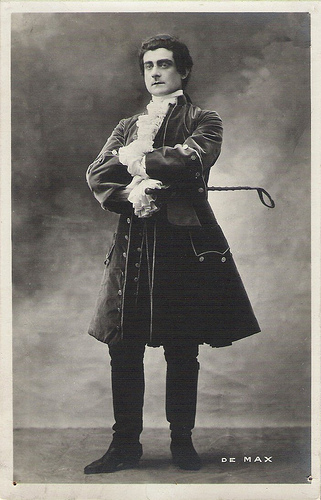
French postcard.
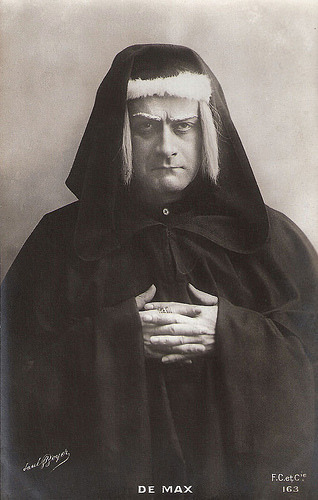
French postcard by F.C. et Cie, no. 163. Photo: Saul Boyer.
Film d'art
Édouard de Max was born as Eduard-Alexandru Max in Iasi, Romania, in 1869.
He graduated from the Conservatory of Paris, and from the 1890s on he appeared on the French stage. He played frequently opposite Sarah Bernhardt .
He made his film debut in America, in the Vitagraph short MacBeth (J. Stuart Blackton, 1908). It is the earliest known film version of the play by William Shakespeare.
Between 1908 and 1912, he appeared in a handful films of the French company Film d'art, including Polyeucte (Camille de Morlhon, 1910), and Athalie (Albert Capellani, Michel Carré, 1910).
In 1912 he appeared in Une vengeance d'Edgar Poë/The Vengeance of Edgard Poe (Gérard Bourgeois, 1912) after a script by Abel Gance based on a story by Edgar Allan Poe, and ha also acted in another horror film Le masque d'horreur/The Mask of Horror ( Abel Gance , 1912) with Charles de Rochefort .
In 1912 De Max also appeared in an adaptation of Alexandre Dumas' famous novel Les Trois Mousquetaires/The Three Musketeers (André Calmettes, Henri Pouctal, 1912). Emile Dehelly played D'Artagnan.
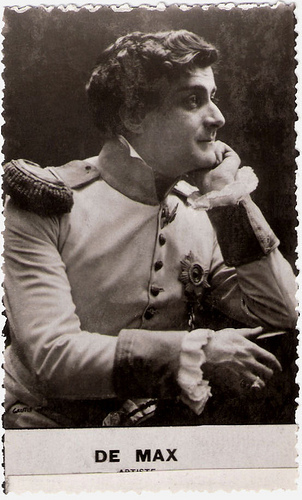
French collector's card.
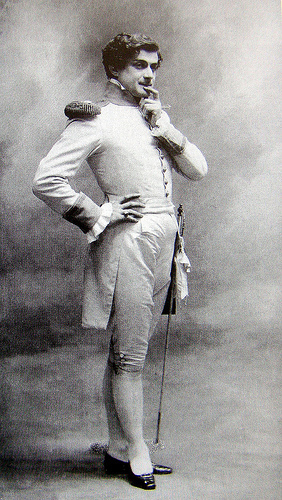
Photo. Collection: Michel Thomas (Flickr).
Silent super-serial
In 1920 Édouard de Max also appeared as Richelieu in the second adaptation, Les Trois Mousquetaires/The Three Musketeers (Henri Diamant Berger, 1921). It was a French twelve-hour film divided into one-hour chapters, produced by Pathé Frères. This silent super-serial was designed to be released as a serial in consecutive weeks over a three-month period.
De Max again played Richelieu in Henri Diamant-Berger's sequel to Les trois mousquetaires: Vingts ans après/Five Years Later (1922), followed by roles in Diamant-Berger's films Les mauvais garçons/The Bad Boys (1922) and Milady (1923).
He also appeared in the Italian historical epic Messalina/The Fall of an Empress (Enrico Guazzoni, 1922) starring Rina De Liguoro .
That year he also appeared opposite a young Maurice Chevalier in Le mauvais garçon/Bad Boy (1922, Henri Diamant-Berger).
Two years later, in 1924, Édouard de Max died in Paris. He was 55.
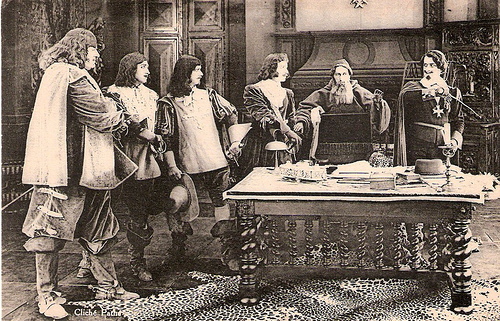
French postcard by M. Le Deley, Paris. Photo: still from Les Trois Mousquetaires/The Three Musketeers (Henri Diamant Berger, 1921), produced by Pathé Consortium Cinéma. Édouard de Max played Cardinal Richelieu.
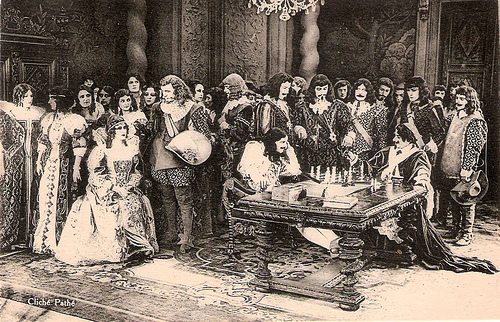
French postcard by M. Le Deley, Paris. Photo: still from Les Trois Mousquetaires/The Three Musketeers (Henri Diamant Berger, 1921), produced by Pathé Consortium Cinéma.
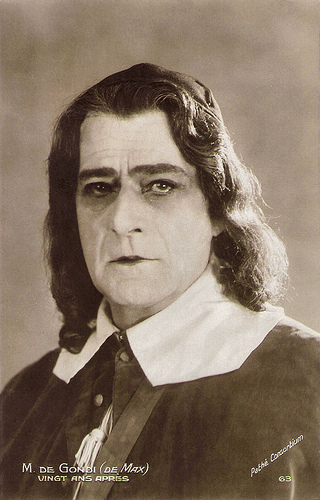
French postcard by Editions Cinémagazine, no. 63. Photo: Pathé Consortium. Édouard de Max as Monsieur de Gondi (and not as Richelieu as IMDb claims) in Vingt ans après (1922), Henri Diamant-Berger's sequel to his earlier film Les trois mousquetaires (1921).
Sources: Rudmer Canjels (Beyond the Cliffhanger: distributing silent serials); Richard Abel (French Cinema - The First Wave 1915-1929), Wikipedia, and .

French postcard.

French postcard by F.C. et Cie, no. 163. Photo: Saul Boyer.
Film d'art
Édouard de Max was born as Eduard-Alexandru Max in Iasi, Romania, in 1869.
He graduated from the Conservatory of Paris, and from the 1890s on he appeared on the French stage. He played frequently opposite Sarah Bernhardt .
He made his film debut in America, in the Vitagraph short MacBeth (J. Stuart Blackton, 1908). It is the earliest known film version of the play by William Shakespeare.
Between 1908 and 1912, he appeared in a handful films of the French company Film d'art, including Polyeucte (Camille de Morlhon, 1910), and Athalie (Albert Capellani, Michel Carré, 1910).
In 1912 he appeared in Une vengeance d'Edgar Poë/The Vengeance of Edgard Poe (Gérard Bourgeois, 1912) after a script by Abel Gance based on a story by Edgar Allan Poe, and ha also acted in another horror film Le masque d'horreur/The Mask of Horror ( Abel Gance , 1912) with Charles de Rochefort .
In 1912 De Max also appeared in an adaptation of Alexandre Dumas' famous novel Les Trois Mousquetaires/The Three Musketeers (André Calmettes, Henri Pouctal, 1912). Emile Dehelly played D'Artagnan.

French collector's card.

Photo. Collection: Michel Thomas (Flickr).
Silent super-serial
In 1920 Édouard de Max also appeared as Richelieu in the second adaptation, Les Trois Mousquetaires/The Three Musketeers (Henri Diamant Berger, 1921). It was a French twelve-hour film divided into one-hour chapters, produced by Pathé Frères. This silent super-serial was designed to be released as a serial in consecutive weeks over a three-month period.
De Max again played Richelieu in Henri Diamant-Berger's sequel to Les trois mousquetaires: Vingts ans après/Five Years Later (1922), followed by roles in Diamant-Berger's films Les mauvais garçons/The Bad Boys (1922) and Milady (1923).
He also appeared in the Italian historical epic Messalina/The Fall of an Empress (Enrico Guazzoni, 1922) starring Rina De Liguoro .
That year he also appeared opposite a young Maurice Chevalier in Le mauvais garçon/Bad Boy (1922, Henri Diamant-Berger).
Two years later, in 1924, Édouard de Max died in Paris. He was 55.

French postcard by M. Le Deley, Paris. Photo: still from Les Trois Mousquetaires/The Three Musketeers (Henri Diamant Berger, 1921), produced by Pathé Consortium Cinéma. Édouard de Max played Cardinal Richelieu.

French postcard by M. Le Deley, Paris. Photo: still from Les Trois Mousquetaires/The Three Musketeers (Henri Diamant Berger, 1921), produced by Pathé Consortium Cinéma.

French postcard by Editions Cinémagazine, no. 63. Photo: Pathé Consortium. Édouard de Max as Monsieur de Gondi (and not as Richelieu as IMDb claims) in Vingt ans après (1922), Henri Diamant-Berger's sequel to his earlier film Les trois mousquetaires (1921).
Sources: Rudmer Canjels (Beyond the Cliffhanger: distributing silent serials); Richard Abel (French Cinema - The First Wave 1915-1929), Wikipedia, and .
Published on May 21, 2014 23:00
May 20, 2014
Rosamund John
Grey-eyed, red-headed Rosamund John (1913–1998) was a major English film and stage actress of the 1940s, known for playing gentle mannered women. She played leading roles in such film classics as The Tawny Pipit (1944), The Way to the Stars (1945), and Green For Danger (1946).
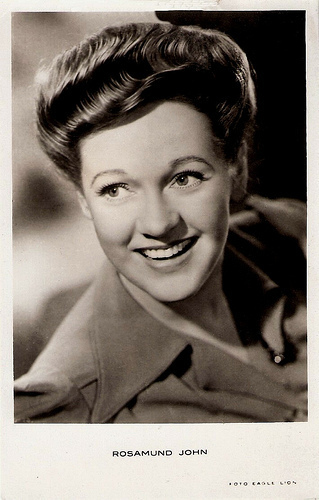
Dutch postcard by Hemo. Photo: Eagle Lion.
Well-bred Heroin
Rosamund John was born Nora Rosamund Jones in Tottenham in North London in 1913. She also grew up in Tottenham and was educated at the Tottenham Drapers' College. Then she studied at the Embassy School of Acting.
After a year in France at the age of 19, she returned to London and was introduced by a former history teacher to the actor-director Milton Rosmer, who cast her in small stage roles.
Billed as Rosamund Jones, she made her film debut as a Scottish girl in his The Secret of the Loch (Milton Rosmer,1934). The film starred Seymour Hicks as a scientist out to prove the existence of the Loch Ness Monster.
Two years later, she made her first appearance on the West End stage in Anthony and Cleopatra. Spotted by the legendary impresario C.B. Cochran she went on to appear in the revue Home and Beauty. In 1940 she starred opposite Robert Donat in G.B. Shaw's Devil’s Disciple at the Adelphi Theatre.
After a screen test, Leslie Howard gave John a leading role in The First of the Few (Leslie Howard, 1942). In his 1998 obituary of John in The Independent , Tom Vallance writes: “As the understanding wife of the Spitfire designer R.J. Mitchell, John projected an extremely English combination of reticence, loyalty and gentle determination, and the film was a big success.“
As a result she went on to make two more films with Howard as producer, The Gentle Sex (Maurice Elvey, Leslie Howard, 1943) and The Lamp Still Burns (Maurice Elvey, 1943) with Stewart Granger . Howard taught her all about filmmaking, but during the production of The Lamp Still Burns he died during a fatal air trip to Lisbon.
Rosamund John became a popular film and stage actress who was known for playing gentle mannered women. In the comedy Tawny Pipit (Bernard Miles, 1944), she plays a nurse who joins a vicar and convalescing pilot to save rare birds nesting near an English village and ensure that they can hatch undisturbed in the middle of a war.
Another success was the outstanding film about life on a British bomber station, The Way to the Stars (Anthony Asquith, 1945). She played ‘Toddy’, the compassionate hotel landlady who loses both her husband, RAF pilot Michael Redgrave , and the American airman she later befriends.
Tom Vallance describes Rosamund John as “one of Britain's most popular film actresses of the Forties, Rosamund John was voted second only to Margaret Lockwood as the country's favourite British female star in 1944” and as “one of the most interesting of the well-bred heroines who dominated the British screen of that time.”
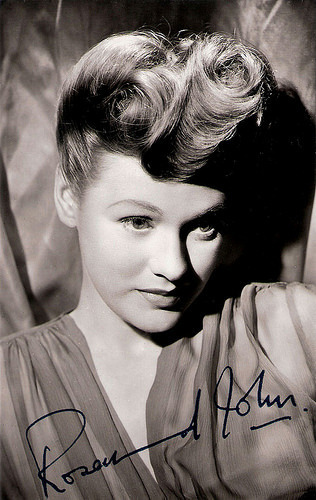
British card.
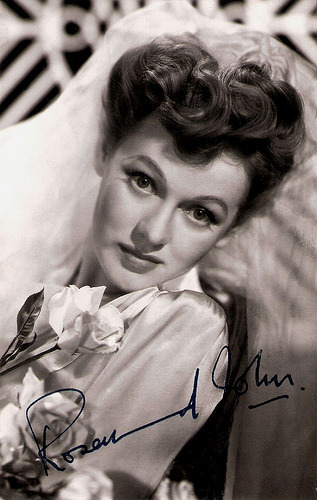
British card.
Cleverer and More Offbeat
After the war, Rosamund John starred in Green for Danger (Sidney Gilliatt, 1946), an inventive murder mystery set in a hospital operating theatre with Alastair Sim as the eccentric police inspector.
Bruce Eder at AllMovie : “the movie's casting, plotting, and execution served as a prime example of how British studios were going to compete with their higher-budgeted American rivals in the years after the war: by making movies that were cleverer and more offbeat than anything coming out of America”.
Green for Danger was again a success, but it would be the last of her major films. The psychological thriller The Upturned Glass (1947) was stolen by its star and co-producer James Mason , and, Roy Boulting's Fame is the Spur (Lawrence Huntington, 1947) was not a popular success.
A film about the effect of warring parents on a child, No Place for Jennifer (Henry Cass, 1949), was a big success for the child star Janette Scott, after which John made only one more major film, Street Corner (Muriel Box, 1953), in which she and Anne Crawford portrayed two policewomen.
Rosamund John was intensely political. In 1949 she was nominated to be the Actors Representative on the Working Party on Film Production Costs and for many years she was a leading figure with Equity, the British actors trade union.
In 1950, she married young naval officer and later Labour MP John Silkin. In the following years, John often attended the House of Commons to hear her husband speak. In the 1970s, Silkin became Minister for Agriculture, Fisheries and Food. It was a long and happy marriage which ended with her husband’s death in 1987.
John's final film was the B-film Operation Murder (Ernest Morris, 1956), but she had virtually abandoned her acting career for politics and for marriage. Later she made several television appearances including a guest cameo in the TV series Crimes of Passion (1971).
John was twice married, first to film editor Russell Lloyd, from 1943–1949, and secondly to John Silkin (1950–1987). They had one son, Rory L. F. Silkin (1954). Rosamund John died from natural causes in London in 1998, aged 85.
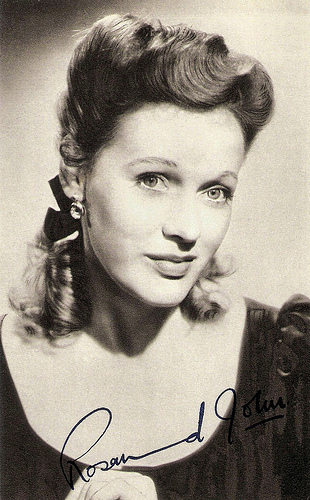
British card.
Sources: Tom Vallance (The Independent), Bruce Eder (AllMovie), (IMDb), BritMovie, AllMovie, Wikipedia, and .

Dutch postcard by Hemo. Photo: Eagle Lion.
Well-bred Heroin
Rosamund John was born Nora Rosamund Jones in Tottenham in North London in 1913. She also grew up in Tottenham and was educated at the Tottenham Drapers' College. Then she studied at the Embassy School of Acting.
After a year in France at the age of 19, she returned to London and was introduced by a former history teacher to the actor-director Milton Rosmer, who cast her in small stage roles.
Billed as Rosamund Jones, she made her film debut as a Scottish girl in his The Secret of the Loch (Milton Rosmer,1934). The film starred Seymour Hicks as a scientist out to prove the existence of the Loch Ness Monster.
Two years later, she made her first appearance on the West End stage in Anthony and Cleopatra. Spotted by the legendary impresario C.B. Cochran she went on to appear in the revue Home and Beauty. In 1940 she starred opposite Robert Donat in G.B. Shaw's Devil’s Disciple at the Adelphi Theatre.
After a screen test, Leslie Howard gave John a leading role in The First of the Few (Leslie Howard, 1942). In his 1998 obituary of John in The Independent , Tom Vallance writes: “As the understanding wife of the Spitfire designer R.J. Mitchell, John projected an extremely English combination of reticence, loyalty and gentle determination, and the film was a big success.“
As a result she went on to make two more films with Howard as producer, The Gentle Sex (Maurice Elvey, Leslie Howard, 1943) and The Lamp Still Burns (Maurice Elvey, 1943) with Stewart Granger . Howard taught her all about filmmaking, but during the production of The Lamp Still Burns he died during a fatal air trip to Lisbon.
Rosamund John became a popular film and stage actress who was known for playing gentle mannered women. In the comedy Tawny Pipit (Bernard Miles, 1944), she plays a nurse who joins a vicar and convalescing pilot to save rare birds nesting near an English village and ensure that they can hatch undisturbed in the middle of a war.
Another success was the outstanding film about life on a British bomber station, The Way to the Stars (Anthony Asquith, 1945). She played ‘Toddy’, the compassionate hotel landlady who loses both her husband, RAF pilot Michael Redgrave , and the American airman she later befriends.
Tom Vallance describes Rosamund John as “one of Britain's most popular film actresses of the Forties, Rosamund John was voted second only to Margaret Lockwood as the country's favourite British female star in 1944” and as “one of the most interesting of the well-bred heroines who dominated the British screen of that time.”

British card.

British card.
Cleverer and More Offbeat
After the war, Rosamund John starred in Green for Danger (Sidney Gilliatt, 1946), an inventive murder mystery set in a hospital operating theatre with Alastair Sim as the eccentric police inspector.
Bruce Eder at AllMovie : “the movie's casting, plotting, and execution served as a prime example of how British studios were going to compete with their higher-budgeted American rivals in the years after the war: by making movies that were cleverer and more offbeat than anything coming out of America”.
Green for Danger was again a success, but it would be the last of her major films. The psychological thriller The Upturned Glass (1947) was stolen by its star and co-producer James Mason , and, Roy Boulting's Fame is the Spur (Lawrence Huntington, 1947) was not a popular success.
A film about the effect of warring parents on a child, No Place for Jennifer (Henry Cass, 1949), was a big success for the child star Janette Scott, after which John made only one more major film, Street Corner (Muriel Box, 1953), in which she and Anne Crawford portrayed two policewomen.
Rosamund John was intensely political. In 1949 she was nominated to be the Actors Representative on the Working Party on Film Production Costs and for many years she was a leading figure with Equity, the British actors trade union.
In 1950, she married young naval officer and later Labour MP John Silkin. In the following years, John often attended the House of Commons to hear her husband speak. In the 1970s, Silkin became Minister for Agriculture, Fisheries and Food. It was a long and happy marriage which ended with her husband’s death in 1987.
John's final film was the B-film Operation Murder (Ernest Morris, 1956), but she had virtually abandoned her acting career for politics and for marriage. Later she made several television appearances including a guest cameo in the TV series Crimes of Passion (1971).
John was twice married, first to film editor Russell Lloyd, from 1943–1949, and secondly to John Silkin (1950–1987). They had one son, Rory L. F. Silkin (1954). Rosamund John died from natural causes in London in 1998, aged 85.

British card.
Sources: Tom Vallance (The Independent), Bruce Eder (AllMovie), (IMDb), BritMovie, AllMovie, Wikipedia, and .
Published on May 20, 2014 23:00
May 19, 2014
Solser & Hesse
Piet Hesse (1872-1936) and Abraham (Lion) Solser (1877-1915) were two Dutch comedians of the late 19th and early 20th century.
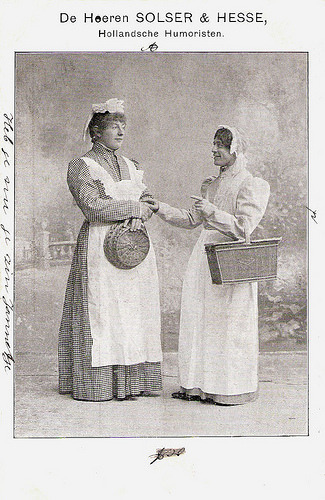
Dutch postcard.
The Ladies Wip and Snip
Solser came from a family of stage actors and variety artists. After the death of his brother Michel, he joined the stage company of his father. His sister was variety artist and comedian Adrienne Solser, who starred in several Dutch film comedies of the 1920s.
With his brother Louis, Lion formed a comic duo that performed in varieties and at fairs. After they split up, Lion formed a comedy duo with Piet Hesse in 1896. It was an immediate success.
They also had a popular acting company, Het gezelschap Solser & Hesse, and they acted in some of the first Dutch films of the late 19th and early 20th Century.
Solser & Hesse played in the first Dutch fiction film Gestoorde hengelaar/Disturbed Angler (M.H. Laddé, 1896). Later they also appeared in two short films from 1900 and 1906, both titled Solser en Hesse. All three films are missing.
For Edison they also made some records. In 1899, Lion married actress Adrienne Willemsens, and he often worked together with her on stage.
Solser often played roles in drag and with Hesse, he created the ladies Wip and Snip. They probably inspired Jacques van Tol when he later wrote the famous drag act Snip and Snap for Dutch comedians Piet Muyselaar and Willy Walden .
In 1915, Lion Solser committed suicide at the age of 38.
Piet Hesse continued their popular duo with Lion's brother Louis. During the late 1920s and 1930s he worked as an impresario and exploited with Simon Delmonte the traveling theatre, Loge Schouwburg.
Hesse's life partner was Anna Slauderhof. Piet Hesse died in 1936.
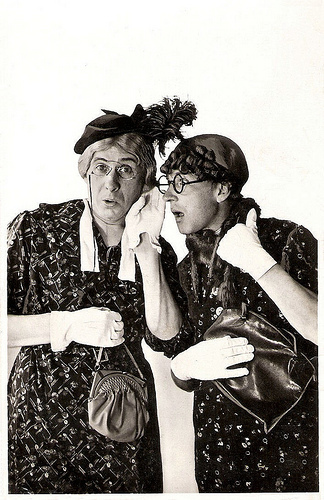
Dutch postcard by L. Nieweg, Amersfoort. Photo: W. Schuurman, Den Haag. Piet Muyselaar and Willy Walden as Snip and Snap.
Sources: Piet Hein Honig (Acteurs- en kleinkunstenaarslexicon) (Dutch), Film in the Netherlands, Joods Amsterdam (Dutch) and Wikipedia.

Dutch postcard.
The Ladies Wip and Snip
Solser came from a family of stage actors and variety artists. After the death of his brother Michel, he joined the stage company of his father. His sister was variety artist and comedian Adrienne Solser, who starred in several Dutch film comedies of the 1920s.
With his brother Louis, Lion formed a comic duo that performed in varieties and at fairs. After they split up, Lion formed a comedy duo with Piet Hesse in 1896. It was an immediate success.
They also had a popular acting company, Het gezelschap Solser & Hesse, and they acted in some of the first Dutch films of the late 19th and early 20th Century.
Solser & Hesse played in the first Dutch fiction film Gestoorde hengelaar/Disturbed Angler (M.H. Laddé, 1896). Later they also appeared in two short films from 1900 and 1906, both titled Solser en Hesse. All three films are missing.
For Edison they also made some records. In 1899, Lion married actress Adrienne Willemsens, and he often worked together with her on stage.
Solser often played roles in drag and with Hesse, he created the ladies Wip and Snip. They probably inspired Jacques van Tol when he later wrote the famous drag act Snip and Snap for Dutch comedians Piet Muyselaar and Willy Walden .
In 1915, Lion Solser committed suicide at the age of 38.
Piet Hesse continued their popular duo with Lion's brother Louis. During the late 1920s and 1930s he worked as an impresario and exploited with Simon Delmonte the traveling theatre, Loge Schouwburg.
Hesse's life partner was Anna Slauderhof. Piet Hesse died in 1936.

Dutch postcard by L. Nieweg, Amersfoort. Photo: W. Schuurman, Den Haag. Piet Muyselaar and Willy Walden as Snip and Snap.
Sources: Piet Hein Honig (Acteurs- en kleinkunstenaarslexicon) (Dutch), Film in the Netherlands, Joods Amsterdam (Dutch) and Wikipedia.
Published on May 19, 2014 23:00
May 18, 2014
Albert Finney
Dynamic, often explosive, stage and screen star Albert Finney (1936) was one of the working class and provincial actors that revolutionized British theatre and film in the 1950s and 1960s as one of the ‘angry young men’ of the Kitchen Sink Theatre and Free Cinema wave. Although his early fame was later tempered by long absences from major motion pictures, he continues to earn awards and acclaim in a varied five-decade career on stage, films, and television.

East-German postcard by VEB Progress Film-Vertrieb, Berlin, no. 1616, 1961. Retail price: 0,20 DM. Photo: Progress. Publicity still for Saturday Night and Sunday Morning (Karel Reisz, 1960).
Successful Bookmaker
Albert Finney was born in the working-class town of Salford, England, to Alice Finney-Hobson and Albert Finney, Sr. in 1936. Although he was born working class, his was a relatively privileged upbringing as his father was a successful bookmaker.
He trained at the RADA (Royal Academy of Dramatic Art), where his classmates included Alan Bates and Peter O'Toole.
He began his stage career with the Birmingham Repertory Company playing Brutus in Julius Caesar. He made his London debut in the company's production of George Bernard Shaw's Caesar and Cleopatra in 1956.
Two years later, he earned critical acclaim opposite Charles Laughton in a West End production of Jane Arden's The Party, directed by Laughton.
He then joined the famed Shakespeare Memorial Theatre at Stratford-on-Avon for their 100th anniversary season, performing Cassio in Othello (directed by Tony Richardson with Paul Robeson in the lead), reteaming with Laughton for A Midsummer Night's Dream as Lysander and understudying Laurence Olivier 's Coriolanus.
His cinema debut was a small role as Laurence Olivier's son in The Entertainer (Tony Richardson, 1960). His triumphant performance on the London stage as Billy Liar (1960) raised his profile higher.

East-German postcard by VEB Progress Film-Vertrieb, Berlin, no. 1615, 1961-1962. Photo: still from Saturday Night and Sunday Morning (Karel Reisz, 1960) with Shirley Anne Field.
Angry Young Man Cinema
Albert Finney's upbringing in Lancashire, a region of mills and smokestacks, exposed him to the kind of social injustice and economic hardship that helped prepare him for his first leading film role as a nonconformist, disillusioned factory worker in Saturday Night and Sunday Morning (1960). The film directed by Karel Reisz and produced by Tony Richardson and based on the novel by Alan Sillitoe brought Finney worldwide acclaim.
Mike Cummings at AllMovie calls the film “a milestone in the development of British realist cinema” and TCM names it “a classic of British ‘angry young man’ cinema”.
Finney was originally chosen for the title role in Lawrence of Arabia (David Lean, 1962) after a screen test shot over four days at a cost of £100,000. He later balked at the film's monumental shooting schedule, and did not want to commit to such a long term contract.
Finney cemented his film stardom with the lead role in the lavish and bawdy Tom Jones (Tony Richardson, 1963), adapted by screenwriter John Osborne from the Henry Fielding novel of the same name. He earned an Oscar nomination for his rakish, startlingly handsome and picaresque hero in this rollicking, uproarious hit which won four Academy Awards.
Rather than attend the Oscar ceremony in 1964, he went on vacation sailing in the South Seas. When informed that he had been beaten as Best Actor by Sidney Poitier, he offered Poitier his heartfelt congratulations.
He later would be nominated again for the Academy Award for Best Actor for Murder on the Orient Express (1974), The Dresser (1983), and Under the Volcano (1984). He was also nominated for Academy Award for Best Supporting Actor for his performance in Erin Brockovich (2000). Despite his nominations, he has yet to appear in person at an Oscar ceremony.
East-German postcard by VEB Progress Film-Vertrieb, Berlin, no. 1614, 1961. Retail price: 0,20 DM. Photo: Progress. Publicity still from Saturday Night and Sunday Morning (1960).
Disdainful of his Pretty Boy Image
In 1963, Albert Finney took Broadway by storm in John Osborne's Luther, helmed by Tony Richardson.
Then he reteamed with Karel Reisz for Night Must Fall (1964), on which Finney made his debut as producer. In 1965, he formed Memorial Films in association with actor Michael Medwin, responsible for several outstanding films including Lindsay Anderson's If... (1968) and O Lucky Man! (1973).
With hints of autobiography, in 1967 he directed and starred in Charlie Bubbles (1967), a film from a Shelagh Delaney script about the disenchantments of success. The loss of youth was also at the centre of Two for the Road (1967, Stanley Donen), in which he starred with Audrey Hepburn .
After these productions his film appearances became less frequent. With absolutely no interest in being a ‘personality’ actor and disdainful of his pretty boy image, Finney took pictures for their fun value, hamming his way through the title role of Scrooge (Ronald Neame, 1970), a handsome musicalization of Charles Dickens' A Christmas Carol, and delivering a tongue-in-cheek portrayal of a Humphrey Bogart wannabe in Gumshoe (Stephen Frears, 1971), another offering from his production company.
In 1974, he was only the third choice after Alec Guinness and Paul Scofield to play Belgian master detective Hercule Poirot in the star-studded Murder on the Orient Express (Sidney Lumet, 1974), but author Agatha Christie felt Finney's performance came closest to her idea of Poirot.
Finney was so well-known for the role that he complained that it typecast him for a number of years. After Murder on the Orient Express, Finney would appear in only one film over the next seven years, playing a small role in The Duellists (Ridley Scott, 1977).
He directed several plays while associate artistic director of London's Royal Court Theatre from 1972-75. As a member of the National Theatre beginning in 1975, he concentrated exclusively on stage acting, portraying the title roles of Hamlet, Tamburlaine the Great, Macbeth and Uncle Vanya, among his varied work.
Finney was twice nominated for Broadway's Tony Award as Best Actor: in 1964 for playing the title character of Martin Luther in John Osborne's Luther, and in 1968 for Peter Nichols' A Day in the Death of Joe Egg. Both plays were adapted to the screen with other actors. Finney was a member of the Royal Shakespeare Company (RSC) in Stratford-Upon-Avon, England, where he performed for three seasons in the early 1980s.
Albert Finney in Alpha Beta by E. A. Whitehead. Royal Court Theatre 1972. Photo: John Haynes. Collection: Performing Arts / Artes Escénicas (Flickr).
Powerful, Sexually-charged, Rage-filled Performance
Albert Finney found new cinema success in Alan Parker's harrowing portrait of divorce, Shoot the Moon (1981), giving a powerful, sexually-charged, rage-filled performance as a writer crazed with jealousy that his wife (Diane Keaton) and children seem to be getting along fine without him since his departure.
After pocketing a reported $1 million to play Daddy Warbucks in the huge hit Annie (John Huston, 1982), he essayed the aging Donald Wolfit-like actor-manager to Tom Courtenay's The Dresser (Peter Yates, 1983), with both actors earning Best Actor Oscar nominations for their work.
He was perhaps never better as the gruellingly drunk diplomat of Under the Volcano (John Huston, 1984), adapted from Malcolm Lowry's autobiographical novel set in 1930s Mexico. He earned his fourth Best Actor Oscar nomination for an extraordinary performance requiring him onscreen almost the entire film.
Finney reprised his stage role as a deceptive, drunken Chicago gangster in Orphans (Alan J. Pakula, 1987), demonstrating his flair for dialects with an authentic South Side accent.
Another highlight was his charismatic Irish gang leader in the Coen brothers’ Miller's Crossing (1990). Finney made an appearance as the Judge during the trial at The Wall: Live in Berlin (Ken O'Neill, Roger Waters, 1990), a video recording of the 1990 Berlin benefit concert in which Roger Waters leads an all star cast in performing his famous concept album.
He offered a masterful performance as the public school teacher-scholar at the centre of a remake of The Browning Version (Mike Figgis, 1994).
Finney made several television productions for the BBC in the 1990s, including The Green Man (Elijah Moshinsky, 1990), based on a story by Kingsley Amis, the acclaimed drama A Rather English Marriage (Paul Seed, 1998) with Tom Courtenay, and the lead role in Dennis Potter's final two plays, Karaoke (Renny Rye, 1996) and Cold Lazarus (Renny Rye, 1997). In the latter he played a frozen, disembodied head.
Trailer of Saturday Night and Sunday Morning (1960). Source: Britfix (YouTube).
Trailer of Two For the Road (1967). Source: Freakstorm2 (YouTube).
Big Fish
Albert Finney essayed a former racing commissioner in the film adaptation of Sam Shepard's Simpatico (Matthew Warchus, 1999), a role particularly well-suited to this breeder of horses and son of a bookie.
He then found himself in the commercial smash Erin Brockovich (Steven Soderbergh, 2000), playing the skeptical, but open-minded California lawyer boss of Julia Roberts’ titular legal assistant whose interest in a cancer cluster case, gradually re-energized him for what becomes the case of his career.
That same year, he had a cameo in Traffic (Steven Soderbergh, 2000). In 2002, he played Winston Churchill opposite Vanessa Redgrave in the HBO drama The Gathering Storm (Richard Loncraine, 2002), for which he won BAFTA, Golden Globe and Emmy awards as Best Actor.
He played the leading role in the series My Uncle Silas (Tom Clegg, Philip Saville, 2001-2003), about a Cornish country gentleman looking after his great-nephew.
He received a Golden Globe nomination for his role as the senior Ed Bloom, a man whose tendency toward fanciful self-mythologicizing puts him at odds with his disillusioned son (Billy Crudup) in Big Fish (Tim Burton, 2003). Finney also had a voice-over role as Finnis Everglot in Tim Burton's animated film Corpse Bride (Tim Burton, 2005).
His most recent films were the successful action thriller The Bourne Ultimatum (Paul Greengrass, 2007) starring Matt Damon, the thriller Before the Devil Knows You're Dead (Sidney Lumet, 2007), with Philip Seymour Hoffman and the 23rd installment of the James Bond series, Skyfall (Sam Mendes, 2012).
Albert Finney married four times. His spouses are Jane Wenham (1957-1961), Anouk Aimée (1970-1978), Katherine Attson (1989-1991) and Pene Delmage (2006-present). He has two children: film technician Simon Finney with Jane Wenham, and actor Declan Finney with Katherine Attson.
He turned down the offer of a C.B.E. (Commander of the Order of the British Empire) in 1980 and a Knighthood in 2000 for his services to drama.
Trailer of Miller's Crossing (1990). Source: Sparmanator 666 (YouTube).
Trailer of Big Fish (2003). Source: FilmTrailersChannel (YouTube).
Sources: Mike Cummings (AllMovie), (IMDb), TCM Movie Database, Wikipedia, Britmovie and .

East-German postcard by VEB Progress Film-Vertrieb, Berlin, no. 1616, 1961. Retail price: 0,20 DM. Photo: Progress. Publicity still for Saturday Night and Sunday Morning (Karel Reisz, 1960).
Successful Bookmaker
Albert Finney was born in the working-class town of Salford, England, to Alice Finney-Hobson and Albert Finney, Sr. in 1936. Although he was born working class, his was a relatively privileged upbringing as his father was a successful bookmaker.
He trained at the RADA (Royal Academy of Dramatic Art), where his classmates included Alan Bates and Peter O'Toole.
He began his stage career with the Birmingham Repertory Company playing Brutus in Julius Caesar. He made his London debut in the company's production of George Bernard Shaw's Caesar and Cleopatra in 1956.
Two years later, he earned critical acclaim opposite Charles Laughton in a West End production of Jane Arden's The Party, directed by Laughton.
He then joined the famed Shakespeare Memorial Theatre at Stratford-on-Avon for their 100th anniversary season, performing Cassio in Othello (directed by Tony Richardson with Paul Robeson in the lead), reteaming with Laughton for A Midsummer Night's Dream as Lysander and understudying Laurence Olivier 's Coriolanus.
His cinema debut was a small role as Laurence Olivier's son in The Entertainer (Tony Richardson, 1960). His triumphant performance on the London stage as Billy Liar (1960) raised his profile higher.

East-German postcard by VEB Progress Film-Vertrieb, Berlin, no. 1615, 1961-1962. Photo: still from Saturday Night and Sunday Morning (Karel Reisz, 1960) with Shirley Anne Field.
Angry Young Man Cinema
Albert Finney's upbringing in Lancashire, a region of mills and smokestacks, exposed him to the kind of social injustice and economic hardship that helped prepare him for his first leading film role as a nonconformist, disillusioned factory worker in Saturday Night and Sunday Morning (1960). The film directed by Karel Reisz and produced by Tony Richardson and based on the novel by Alan Sillitoe brought Finney worldwide acclaim.
Mike Cummings at AllMovie calls the film “a milestone in the development of British realist cinema” and TCM names it “a classic of British ‘angry young man’ cinema”.
Finney was originally chosen for the title role in Lawrence of Arabia (David Lean, 1962) after a screen test shot over four days at a cost of £100,000. He later balked at the film's monumental shooting schedule, and did not want to commit to such a long term contract.
Finney cemented his film stardom with the lead role in the lavish and bawdy Tom Jones (Tony Richardson, 1963), adapted by screenwriter John Osborne from the Henry Fielding novel of the same name. He earned an Oscar nomination for his rakish, startlingly handsome and picaresque hero in this rollicking, uproarious hit which won four Academy Awards.
Rather than attend the Oscar ceremony in 1964, he went on vacation sailing in the South Seas. When informed that he had been beaten as Best Actor by Sidney Poitier, he offered Poitier his heartfelt congratulations.
He later would be nominated again for the Academy Award for Best Actor for Murder on the Orient Express (1974), The Dresser (1983), and Under the Volcano (1984). He was also nominated for Academy Award for Best Supporting Actor for his performance in Erin Brockovich (2000). Despite his nominations, he has yet to appear in person at an Oscar ceremony.
East-German postcard by VEB Progress Film-Vertrieb, Berlin, no. 1614, 1961. Retail price: 0,20 DM. Photo: Progress. Publicity still from Saturday Night and Sunday Morning (1960).
Disdainful of his Pretty Boy Image
In 1963, Albert Finney took Broadway by storm in John Osborne's Luther, helmed by Tony Richardson.
Then he reteamed with Karel Reisz for Night Must Fall (1964), on which Finney made his debut as producer. In 1965, he formed Memorial Films in association with actor Michael Medwin, responsible for several outstanding films including Lindsay Anderson's If... (1968) and O Lucky Man! (1973).
With hints of autobiography, in 1967 he directed and starred in Charlie Bubbles (1967), a film from a Shelagh Delaney script about the disenchantments of success. The loss of youth was also at the centre of Two for the Road (1967, Stanley Donen), in which he starred with Audrey Hepburn .
After these productions his film appearances became less frequent. With absolutely no interest in being a ‘personality’ actor and disdainful of his pretty boy image, Finney took pictures for their fun value, hamming his way through the title role of Scrooge (Ronald Neame, 1970), a handsome musicalization of Charles Dickens' A Christmas Carol, and delivering a tongue-in-cheek portrayal of a Humphrey Bogart wannabe in Gumshoe (Stephen Frears, 1971), another offering from his production company.
In 1974, he was only the third choice after Alec Guinness and Paul Scofield to play Belgian master detective Hercule Poirot in the star-studded Murder on the Orient Express (Sidney Lumet, 1974), but author Agatha Christie felt Finney's performance came closest to her idea of Poirot.
Finney was so well-known for the role that he complained that it typecast him for a number of years. After Murder on the Orient Express, Finney would appear in only one film over the next seven years, playing a small role in The Duellists (Ridley Scott, 1977).
He directed several plays while associate artistic director of London's Royal Court Theatre from 1972-75. As a member of the National Theatre beginning in 1975, he concentrated exclusively on stage acting, portraying the title roles of Hamlet, Tamburlaine the Great, Macbeth and Uncle Vanya, among his varied work.
Finney was twice nominated for Broadway's Tony Award as Best Actor: in 1964 for playing the title character of Martin Luther in John Osborne's Luther, and in 1968 for Peter Nichols' A Day in the Death of Joe Egg. Both plays were adapted to the screen with other actors. Finney was a member of the Royal Shakespeare Company (RSC) in Stratford-Upon-Avon, England, where he performed for three seasons in the early 1980s.
Albert Finney in Alpha Beta by E. A. Whitehead. Royal Court Theatre 1972. Photo: John Haynes. Collection: Performing Arts / Artes Escénicas (Flickr).
Powerful, Sexually-charged, Rage-filled Performance
Albert Finney found new cinema success in Alan Parker's harrowing portrait of divorce, Shoot the Moon (1981), giving a powerful, sexually-charged, rage-filled performance as a writer crazed with jealousy that his wife (Diane Keaton) and children seem to be getting along fine without him since his departure.
After pocketing a reported $1 million to play Daddy Warbucks in the huge hit Annie (John Huston, 1982), he essayed the aging Donald Wolfit-like actor-manager to Tom Courtenay's The Dresser (Peter Yates, 1983), with both actors earning Best Actor Oscar nominations for their work.
He was perhaps never better as the gruellingly drunk diplomat of Under the Volcano (John Huston, 1984), adapted from Malcolm Lowry's autobiographical novel set in 1930s Mexico. He earned his fourth Best Actor Oscar nomination for an extraordinary performance requiring him onscreen almost the entire film.
Finney reprised his stage role as a deceptive, drunken Chicago gangster in Orphans (Alan J. Pakula, 1987), demonstrating his flair for dialects with an authentic South Side accent.
Another highlight was his charismatic Irish gang leader in the Coen brothers’ Miller's Crossing (1990). Finney made an appearance as the Judge during the trial at The Wall: Live in Berlin (Ken O'Neill, Roger Waters, 1990), a video recording of the 1990 Berlin benefit concert in which Roger Waters leads an all star cast in performing his famous concept album.
He offered a masterful performance as the public school teacher-scholar at the centre of a remake of The Browning Version (Mike Figgis, 1994).
Finney made several television productions for the BBC in the 1990s, including The Green Man (Elijah Moshinsky, 1990), based on a story by Kingsley Amis, the acclaimed drama A Rather English Marriage (Paul Seed, 1998) with Tom Courtenay, and the lead role in Dennis Potter's final two plays, Karaoke (Renny Rye, 1996) and Cold Lazarus (Renny Rye, 1997). In the latter he played a frozen, disembodied head.
Trailer of Saturday Night and Sunday Morning (1960). Source: Britfix (YouTube).
Trailer of Two For the Road (1967). Source: Freakstorm2 (YouTube).
Big Fish
Albert Finney essayed a former racing commissioner in the film adaptation of Sam Shepard's Simpatico (Matthew Warchus, 1999), a role particularly well-suited to this breeder of horses and son of a bookie.
He then found himself in the commercial smash Erin Brockovich (Steven Soderbergh, 2000), playing the skeptical, but open-minded California lawyer boss of Julia Roberts’ titular legal assistant whose interest in a cancer cluster case, gradually re-energized him for what becomes the case of his career.
That same year, he had a cameo in Traffic (Steven Soderbergh, 2000). In 2002, he played Winston Churchill opposite Vanessa Redgrave in the HBO drama The Gathering Storm (Richard Loncraine, 2002), for which he won BAFTA, Golden Globe and Emmy awards as Best Actor.
He played the leading role in the series My Uncle Silas (Tom Clegg, Philip Saville, 2001-2003), about a Cornish country gentleman looking after his great-nephew.
He received a Golden Globe nomination for his role as the senior Ed Bloom, a man whose tendency toward fanciful self-mythologicizing puts him at odds with his disillusioned son (Billy Crudup) in Big Fish (Tim Burton, 2003). Finney also had a voice-over role as Finnis Everglot in Tim Burton's animated film Corpse Bride (Tim Burton, 2005).
His most recent films were the successful action thriller The Bourne Ultimatum (Paul Greengrass, 2007) starring Matt Damon, the thriller Before the Devil Knows You're Dead (Sidney Lumet, 2007), with Philip Seymour Hoffman and the 23rd installment of the James Bond series, Skyfall (Sam Mendes, 2012).
Albert Finney married four times. His spouses are Jane Wenham (1957-1961), Anouk Aimée (1970-1978), Katherine Attson (1989-1991) and Pene Delmage (2006-present). He has two children: film technician Simon Finney with Jane Wenham, and actor Declan Finney with Katherine Attson.
He turned down the offer of a C.B.E. (Commander of the Order of the British Empire) in 1980 and a Knighthood in 2000 for his services to drama.
Trailer of Miller's Crossing (1990). Source: Sparmanator 666 (YouTube).
Trailer of Big Fish (2003). Source: FilmTrailersChannel (YouTube).
Sources: Mike Cummings (AllMovie), (IMDb), TCM Movie Database, Wikipedia, Britmovie and .
Published on May 18, 2014 23:00
May 17, 2014
Rosemary Dexter
Rosemary Dexter (1944-2010) was a British film actress of Pakistani origins, who appeared in dozens of Italian films of the 1960s and 1970s.
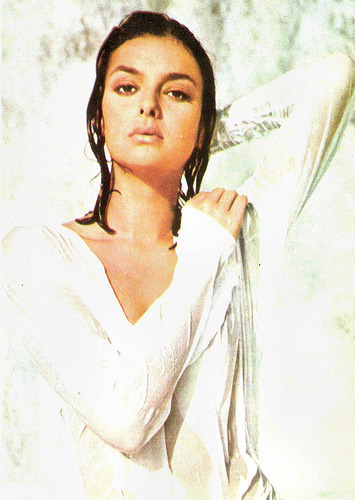
Romanian postcard by Casa Filmului Acin.
For a Few Dollars More
Rosemary (sometimes Rosemarie) Dexter was born in Quetta, British India (now Pakistan), in 1944. She had a British father and an Anglo-Burmese mother.
In the early 1950s her family moved to Italy. Dexter entered the film industry in 1963.
In Rome she met director Ugo Gregoretti who offered her the female lead in his science fiction comedy Omicron (1963) starring Renato Salvatori .
The following year she played Juliet in the Shakespeare adaptation Giulietta e Romeo/Juliet and Romeo (Riccardo Freda, 1964), according the heroine top billing for the first time in history.
In Per qualche dollaro in più/For a Few Dollars More (Sergio Leone, 1964), she played Col. Mortimer’s sister in the flashback scene with Peter Lee Lawrence and Gian Maria Volonté.
She appeared in more Spaghetti Westerns, including El desperado/The Dirty Outlaws (Franco Rossetti, 1967).
Other films were Desideri d'estate/Summer Wish (Silvio Amadio, 1964) with Gabriele Ferzetti , Oltraggio al pudore/All the Other Girls Do! (Silvio Amadio, 1964), and Un uomo a metà/Almost a Man (Vittorio Seta, 1966) starring Jacques Perrin .
Robert Firsching at AllMovie about the latter: “The strong supporting cast, including Lea Padovani and Pier Paolo Capponi, brhttp://de.wikipedia.org/wiki/Rosemary... credence to their roles, but it is De Seta's direction, Perrin's controlled performance, and a relatively subtle score by Ennio Morricone which keep this film from becoming as overwrought as it might have become in other hands.”
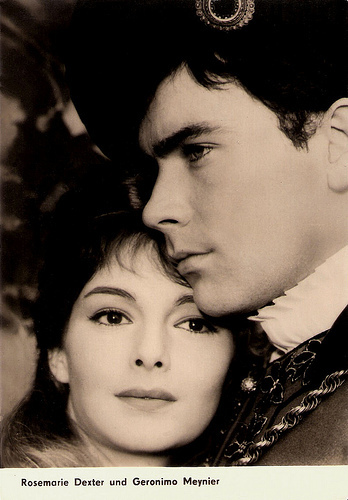
East-German postcard by VEB Progress Filmvertrieb, Berlin, no. 2923, 1967. Photo: publicity still for Giulietta e Romeo/Juliet and Romeo (Riccardo Freda, 1964).
Beautiful Eye Candy
Rosemary Dexter was a very active film actress until mid-seventies.
She acted in international productions as The Shoes of the Fisherman (Michael Anderson, 1968) starring Anthony Quinn.
On TV she guest-starred in Vendetta for the Saint (James P. O'Connolly, 1968), an episode of the popular spy series The Saint, featuring Roger Moore .
She often played the love interest of the hero or the beautiful eye-candy.
Later films include the Easy Rider rip-off Cometogether (Tony Anthony, Saul Swimmer, 1971) with Luciana Paluzzi , the Giallo L'Occhio Nel Labirinto/Eye of The Labyrinth (Mario Caiano, 1971) with Adolfo Celi, and the comedy Mio Dio, come sono caduta in basso!/How Long Can You Fall? (Luigi Comencini, 1974) starring Laura Antonelli.
In 1975, after a photo shoot for the Italian Playboy, she retired from acting.
Her final film was the fantasy Povero Cristo/Poor Christ (Pier Carpi, 1976) with Edmund Purdom .
She went to live in the Villa Leopardi in Recanati on recommendation of Count Vanni and his family with whom Dexter was long-time friends.
In 2010, Rosemary Dexter was found dead in her house in Recanati. She had been suffering from a long illness. Dexter had no relatives and expressed her wish to be cremated after she died.
El desperado/The Dirty Outlaws (Franco Rossetti, 1967). Source: SpaghettiWesternFLIX (YouTube).
Sources: Robert Firsching (AllMovie), Matt Blake (The Wild Eye), Tom B. (Boot Hill), Wikipedia (English and German) and .

Romanian postcard by Casa Filmului Acin.
For a Few Dollars More
Rosemary (sometimes Rosemarie) Dexter was born in Quetta, British India (now Pakistan), in 1944. She had a British father and an Anglo-Burmese mother.
In the early 1950s her family moved to Italy. Dexter entered the film industry in 1963.
In Rome she met director Ugo Gregoretti who offered her the female lead in his science fiction comedy Omicron (1963) starring Renato Salvatori .
The following year she played Juliet in the Shakespeare adaptation Giulietta e Romeo/Juliet and Romeo (Riccardo Freda, 1964), according the heroine top billing for the first time in history.
In Per qualche dollaro in più/For a Few Dollars More (Sergio Leone, 1964), she played Col. Mortimer’s sister in the flashback scene with Peter Lee Lawrence and Gian Maria Volonté.
She appeared in more Spaghetti Westerns, including El desperado/The Dirty Outlaws (Franco Rossetti, 1967).
Other films were Desideri d'estate/Summer Wish (Silvio Amadio, 1964) with Gabriele Ferzetti , Oltraggio al pudore/All the Other Girls Do! (Silvio Amadio, 1964), and Un uomo a metà/Almost a Man (Vittorio Seta, 1966) starring Jacques Perrin .
Robert Firsching at AllMovie about the latter: “The strong supporting cast, including Lea Padovani and Pier Paolo Capponi, brhttp://de.wikipedia.org/wiki/Rosemary... credence to their roles, but it is De Seta's direction, Perrin's controlled performance, and a relatively subtle score by Ennio Morricone which keep this film from becoming as overwrought as it might have become in other hands.”

East-German postcard by VEB Progress Filmvertrieb, Berlin, no. 2923, 1967. Photo: publicity still for Giulietta e Romeo/Juliet and Romeo (Riccardo Freda, 1964).
Beautiful Eye Candy
Rosemary Dexter was a very active film actress until mid-seventies.
She acted in international productions as The Shoes of the Fisherman (Michael Anderson, 1968) starring Anthony Quinn.
On TV she guest-starred in Vendetta for the Saint (James P. O'Connolly, 1968), an episode of the popular spy series The Saint, featuring Roger Moore .
She often played the love interest of the hero or the beautiful eye-candy.
Later films include the Easy Rider rip-off Cometogether (Tony Anthony, Saul Swimmer, 1971) with Luciana Paluzzi , the Giallo L'Occhio Nel Labirinto/Eye of The Labyrinth (Mario Caiano, 1971) with Adolfo Celi, and the comedy Mio Dio, come sono caduta in basso!/How Long Can You Fall? (Luigi Comencini, 1974) starring Laura Antonelli.
In 1975, after a photo shoot for the Italian Playboy, she retired from acting.
Her final film was the fantasy Povero Cristo/Poor Christ (Pier Carpi, 1976) with Edmund Purdom .
She went to live in the Villa Leopardi in Recanati on recommendation of Count Vanni and his family with whom Dexter was long-time friends.
In 2010, Rosemary Dexter was found dead in her house in Recanati. She had been suffering from a long illness. Dexter had no relatives and expressed her wish to be cremated after she died.
El desperado/The Dirty Outlaws (Franco Rossetti, 1967). Source: SpaghettiWesternFLIX (YouTube).
Sources: Robert Firsching (AllMovie), Matt Blake (The Wild Eye), Tom B. (Boot Hill), Wikipedia (English and German) and .
Published on May 17, 2014 23:00
May 16, 2014
Vladimir Ivashov
Soviet actor Vladimir Ivashov (1939-1994) is best known for his film debut in Ballada o Soldate/Ballad of a Soldier (1960). Despite the worldwide acclaim for this film, and the respect he was offered by his peers for his later roles, stardom eluded him. At the end of his life he had to do hard labour at a railroad yard.
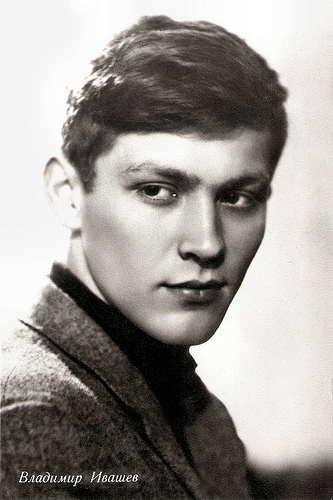
Russian postcard by Izdanije Byuro Propogandy Sovietskogo Kinoiskusstva, no. M 78052, 1962. Retail price: 8 kop.
30.1 million tickets
Vladimir Sergeyevich Ivashov was born in Moscow, Soviet Union (now Russia).
At the age of 19 he was chosen for the lead role in Ballada o Soldate/Ballad of a Soldier (Grigori Chukhrai, 1960). At the time he was a first-year student under Mikhail Romm at Moscow's prestigious VGIK institute.
Ballada o Soldate tells the relatively simple story of the young Russian soldier Alyosha (Ivashov) who gets a two-day vacation for shooting down several tanks during WW II. He hurries to his native village to see his mother and mend the roof of his house. On the way he meets a pretty young girl (Zhanna Prokhorenko) and helps her get home. He also has some errands from his front fellows and spends precious time to help some other people. After all he finally gets to see his mother for just a few precious moments before he is called back to the front. And he never comes home again.
The film was produced at Mosfilm and when it was released in the Soviet Union it sold 30.1 million tickets. The film received considerable praise for both its technical craft and its strong, yet subtle story. Viewed from the earnest, young protagonist, Ballad of a Soldier distanced itself from the fierce propaganda which bound other films before it.
American critics, particularly, hailed it as an instant classic, with the New York Times offering it iconic status. At AllMovie , Tom Wiener writes: "This is one of the least horrific war films ever made, which isn't to say that it glorifies combat or ignores suffering. It also contains one of the saddest expressions of motherly love ever spoken, when Alyosha's mother bids him farewell by crying out, 'I didn't wait for your father, but I'll wait for you.'"
It was in fact the first Russian film to score an American success during the Cold War era. It won also several awards, including the BAFTA Award for Best Film from any Source, the Special jury prize at the Cannes Film Festival of 1960, and was nominated for the Academy Award for Best Original Screenplay.
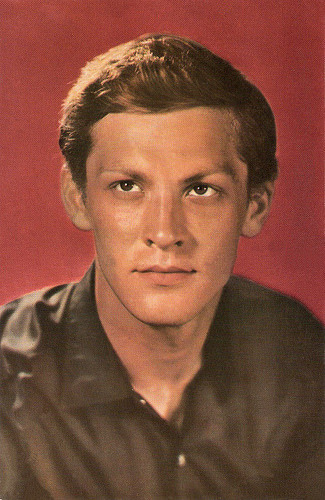
Russian postcard by Izdanije Byuro Propogandy Sovietskogo Kinoiskusstva, no. A 11251, 1966. Photo: B. Vilenkjna / Ter-Ovanesova. (This postcard was printed in an edition of 100.000 cards. The price was 8 kop.).
Weak Heart
Vladimir Ivashov graduated from the VGIK institute in 1963, and was deluged with film offers.
He played subsequent film roles in Khokkeisty/The Hockeyplayers (Rafail Goldin, 1964), and Geroy nashego vremeni (Stanislav Rostotsky, 1965). Most were insignificant comedies and unknown in the West.
There were exceptions. In her 1995 obituary of Ivashov in The Independent , Jeanne Vronskaya writes: "But he left another memorable performance in the lead role of Pechorin, the film directed by Stanislav Rostotski (1967), based on Mikhail Lermontov's Hero of Our Time, in which he plays an aristocratic Russian officer desired by many high-society women." Also interesting is Nass wal Nil, al-/Those People of the Nile (Youssef Chahine, 1968).
Durin the 1970s he played roles in Korona Rossiyskoy imperii, ili snova neulovimye/Crown of Russian Empire, or the Elusives Again (Edmond Keosayan, 1971), A zori zdes tikhie/The Dawns Here Are Quiet (Stanislav Rostotsky, 1974), Kogda nastupaet sentyabr/When September Comes (Edmond Keosayan, 1975), Brillianty dlya diktatury proletariata/Diamonds for the Proletariat (Grigori Kromanov, 1975), and the ingenious science fiction film Test pilota Pirxa/Test Pilot Pirxa (Marek Piestrak, 1978).
Ivashov never repeated his early success. He was offered respect by his peers for his work, but the public had virtually forgotten him.
His later films include Cherez Gobi i Khingan (Vasili Ordynsky, Badrahin Sumhu, 1981), Zhil-byl Pyotr/Once Upon A Time There Was Peter (Sergei Sychyov, 1983), Russkiye bratya/Russian Brothers (Nikolai Fomin, 1991), and Ubiystvo na Zhdanovskoy/The Murder at Zhdanovskaya (Sulambek Mavilov, 1992).
Towards the end of his life, he found it so difficult to find acting jobs that he worked in a railroad yard loading and unloading freight cars.
According to his wife, actress Svetlana Svetlichnaya, Ivashov suffered from a weak heart and the labour-intensive railroad work was presumedly responsible for his early death at the age of 55.
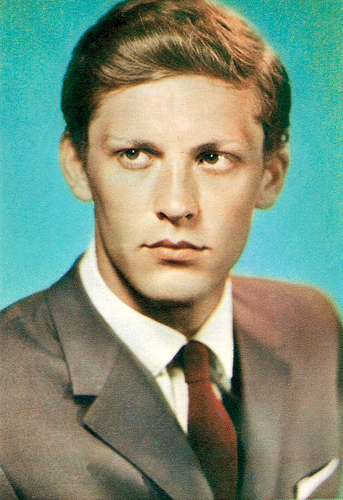
Russian postcard by Izdanije Byuro Propogandy Sovietskogo Kinoiskusstva, no. A 11211, ca. 1964. Photo: Ter-Ovanesova. (This postcard was printed in an edition of 150.000 cards. The price was 8 kop.).
Sources: Jeanne Vronskaya (The Independent), Sandra Brennan (AllMovie), Tom Wiener (AllMovie), Wikipedia, and .

Russian postcard by Izdanije Byuro Propogandy Sovietskogo Kinoiskusstva, no. M 78052, 1962. Retail price: 8 kop.
30.1 million tickets
Vladimir Sergeyevich Ivashov was born in Moscow, Soviet Union (now Russia).
At the age of 19 he was chosen for the lead role in Ballada o Soldate/Ballad of a Soldier (Grigori Chukhrai, 1960). At the time he was a first-year student under Mikhail Romm at Moscow's prestigious VGIK institute.
Ballada o Soldate tells the relatively simple story of the young Russian soldier Alyosha (Ivashov) who gets a two-day vacation for shooting down several tanks during WW II. He hurries to his native village to see his mother and mend the roof of his house. On the way he meets a pretty young girl (Zhanna Prokhorenko) and helps her get home. He also has some errands from his front fellows and spends precious time to help some other people. After all he finally gets to see his mother for just a few precious moments before he is called back to the front. And he never comes home again.
The film was produced at Mosfilm and when it was released in the Soviet Union it sold 30.1 million tickets. The film received considerable praise for both its technical craft and its strong, yet subtle story. Viewed from the earnest, young protagonist, Ballad of a Soldier distanced itself from the fierce propaganda which bound other films before it.
American critics, particularly, hailed it as an instant classic, with the New York Times offering it iconic status. At AllMovie , Tom Wiener writes: "This is one of the least horrific war films ever made, which isn't to say that it glorifies combat or ignores suffering. It also contains one of the saddest expressions of motherly love ever spoken, when Alyosha's mother bids him farewell by crying out, 'I didn't wait for your father, but I'll wait for you.'"
It was in fact the first Russian film to score an American success during the Cold War era. It won also several awards, including the BAFTA Award for Best Film from any Source, the Special jury prize at the Cannes Film Festival of 1960, and was nominated for the Academy Award for Best Original Screenplay.

Russian postcard by Izdanije Byuro Propogandy Sovietskogo Kinoiskusstva, no. A 11251, 1966. Photo: B. Vilenkjna / Ter-Ovanesova. (This postcard was printed in an edition of 100.000 cards. The price was 8 kop.).
Weak Heart
Vladimir Ivashov graduated from the VGIK institute in 1963, and was deluged with film offers.
He played subsequent film roles in Khokkeisty/The Hockeyplayers (Rafail Goldin, 1964), and Geroy nashego vremeni (Stanislav Rostotsky, 1965). Most were insignificant comedies and unknown in the West.
There were exceptions. In her 1995 obituary of Ivashov in The Independent , Jeanne Vronskaya writes: "But he left another memorable performance in the lead role of Pechorin, the film directed by Stanislav Rostotski (1967), based on Mikhail Lermontov's Hero of Our Time, in which he plays an aristocratic Russian officer desired by many high-society women." Also interesting is Nass wal Nil, al-/Those People of the Nile (Youssef Chahine, 1968).
Durin the 1970s he played roles in Korona Rossiyskoy imperii, ili snova neulovimye/Crown of Russian Empire, or the Elusives Again (Edmond Keosayan, 1971), A zori zdes tikhie/The Dawns Here Are Quiet (Stanislav Rostotsky, 1974), Kogda nastupaet sentyabr/When September Comes (Edmond Keosayan, 1975), Brillianty dlya diktatury proletariata/Diamonds for the Proletariat (Grigori Kromanov, 1975), and the ingenious science fiction film Test pilota Pirxa/Test Pilot Pirxa (Marek Piestrak, 1978).
Ivashov never repeated his early success. He was offered respect by his peers for his work, but the public had virtually forgotten him.
His later films include Cherez Gobi i Khingan (Vasili Ordynsky, Badrahin Sumhu, 1981), Zhil-byl Pyotr/Once Upon A Time There Was Peter (Sergei Sychyov, 1983), Russkiye bratya/Russian Brothers (Nikolai Fomin, 1991), and Ubiystvo na Zhdanovskoy/The Murder at Zhdanovskaya (Sulambek Mavilov, 1992).
Towards the end of his life, he found it so difficult to find acting jobs that he worked in a railroad yard loading and unloading freight cars.
According to his wife, actress Svetlana Svetlichnaya, Ivashov suffered from a weak heart and the labour-intensive railroad work was presumedly responsible for his early death at the age of 55.

Russian postcard by Izdanije Byuro Propogandy Sovietskogo Kinoiskusstva, no. A 11211, ca. 1964. Photo: Ter-Ovanesova. (This postcard was printed in an edition of 150.000 cards. The price was 8 kop.).
Sources: Jeanne Vronskaya (The Independent), Sandra Brennan (AllMovie), Tom Wiener (AllMovie), Wikipedia, and .
Published on May 16, 2014 23:00
Paul van Yperen's Blog
- Paul van Yperen's profile
- 13 followers
Paul van Yperen isn't a Goodreads Author
(yet),
but they
do have a blog,
so here are some recent posts imported from
their feed.



